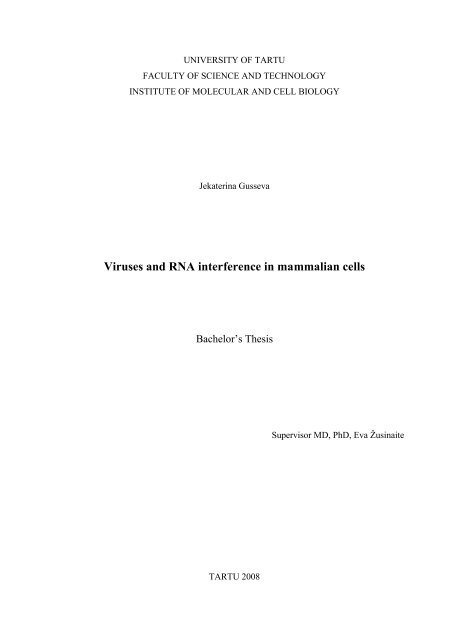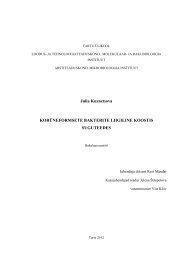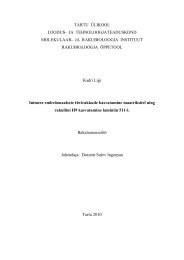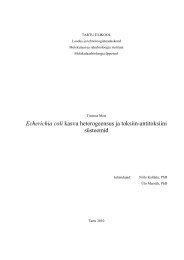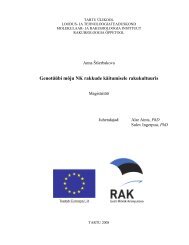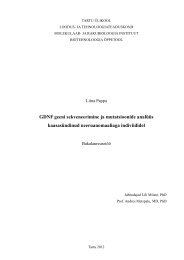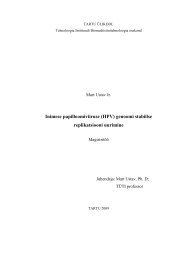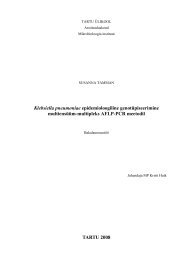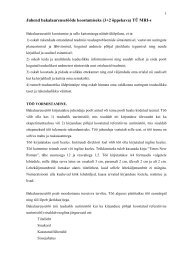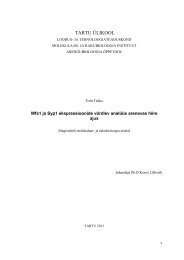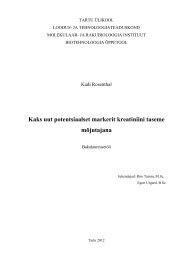Viruses and RNA interference in mammalian cells
Viruses and RNA interference in mammalian cells
Viruses and RNA interference in mammalian cells
You also want an ePaper? Increase the reach of your titles
YUMPU automatically turns print PDFs into web optimized ePapers that Google loves.
UNIVERSITY OF TARTU<br />
FACULTY OF SCIENCE AND TECHNOLOGY<br />
INSTITUTE OF MOLECULAR AND CELL BIOLOGY<br />
Jekater<strong>in</strong>a Gusseva<br />
<strong>Viruses</strong> <strong>and</strong> <strong>RNA</strong> <strong><strong>in</strong>terference</strong> <strong>in</strong> <strong>mammalian</strong> <strong>cells</strong><br />
Bachelor’s Thesis<br />
Supervisor MD, PhD, Eva Žus<strong>in</strong>aite<br />
TARTU 2008
TABLE OF CONTENTS<br />
TABLE OF CONTENTS.......................................................................................................2<br />
ACRONYMS AND ABBREVIATIONS..............................................................................3<br />
INTRODUCTION..................................................................................................................4<br />
LITERAUTRE OVERVIEW................................................................................................5<br />
1. Intracellular anti-viral responses......................................................................................5<br />
Interferone response.......................................................................................................5<br />
<strong>RNA</strong>i………….............................................................................................................7<br />
2. <strong>RNA</strong> <strong><strong>in</strong>terference</strong>................................................................................................................7<br />
History of discovery.....................................................................................................7<br />
General <strong>RNA</strong>i mechanism............................................................................................8<br />
<strong>RNA</strong>i functional elements............................................................................................9<br />
Molecular mechanism of <strong>RNA</strong>i <strong>in</strong> <strong>mammalian</strong> cell...................................................12<br />
L<strong>in</strong>k between mi<strong>RNA</strong>, si<strong>RNA</strong> <strong>and</strong> <strong>RNA</strong>i. (si<strong>RNA</strong> versus mi<strong>RNA</strong>).........................13<br />
3. <strong>RNA</strong>i as an antiviral defense <strong>in</strong> plants, <strong>in</strong>sects <strong>and</strong> <strong>in</strong>tervertebrates..........................15<br />
Plants...........................................................................................................................15<br />
Insects.........................................................................................................................15<br />
Intervertebrates...........................................................................................................16<br />
4. <strong>RNA</strong> <strong><strong>in</strong>terference</strong> <strong>in</strong> mammals........................................................................................17<br />
Artificially triggered <strong>RNA</strong>i........................................................................................17<br />
5. Suppression of cellular anti-viral <strong>RNA</strong>i by viruses.......................................................19<br />
<strong>RNA</strong> silenc<strong>in</strong>g suppressors.........................................................................................20<br />
Virus-encoded mi<strong>RNA</strong>s..............................................................................................21<br />
Further directions of <strong>in</strong>vestigations............................................................................22<br />
CONCLUSIONS..................................................................................................................23<br />
KOKKUVÕTE.....................................................................................................................24<br />
REFERENCES.....................................................................................................................25<br />
2
ACRONYMS AND ABBREVIATIONS<br />
CrPV - Cricket Paralysis virus<br />
CVB3 - Coxsackievirus B3<br />
DCV - Drosophila C virus<br />
ds - double-str<strong>and</strong>ed<br />
EBV - Epste<strong>in</strong>–Barr virus<br />
EGFP - enhanced green fluorescent prote<strong>in</strong><br />
eIF2 – Eukaryotic Initiation Factor<br />
FHV - Flock House virus<br />
FMDV - Foot <strong>and</strong> Mouth Disease Virus<br />
HCC - hepatocellular carc<strong>in</strong>oma<br />
HCV - hepatitis C virus<br />
HIV - Human Immunodeficiency virus<br />
IFN - <strong>in</strong>terferon (InterFeroN)<br />
mi<strong>RNA</strong> - micro <strong>RNA</strong><br />
m<strong>RNA</strong> - Messenger <strong>RNA</strong><br />
NoV - Nodamura virus<br />
nt- nucleotides<br />
ONNV - O’nyong–nyong virus<br />
PTGS - Post-Transcriptional Gene Silenc<strong>in</strong>g<br />
PVX - potato virus X<br />
RdRp – <strong>RNA</strong>-dependent <strong>RNA</strong> polymerase<br />
<strong>RNA</strong>i - <strong>RNA</strong> <strong><strong>in</strong>terference</strong><br />
RSS - <strong>RNA</strong> Silenc<strong>in</strong>g Suppressor<br />
RT - reverse transcriptase<br />
SARS - severe acute respiratory syndrome<br />
SARS-CoV - SARS- associated coronavirus<br />
SINV - S<strong>in</strong>dbis virus<br />
si<strong>RNA</strong> - small or short <strong>in</strong>terfer<strong>in</strong>g <strong>RNA</strong><br />
ss - s<strong>in</strong>gle str<strong>and</strong>ed<br />
TMV - tobacco mosaic virus<br />
VA – virus-associated<br />
VSV - vesicular stomatitis virus<br />
WNV - West Nile virus<br />
3
INTRODUCTION<br />
Epochal discoveries are happen<strong>in</strong>g not very often, but when they are, such f<strong>in</strong>d<strong>in</strong>gs take<br />
their niche <strong>in</strong> the history of humank<strong>in</strong>d. Dur<strong>in</strong>g multiple <strong>in</strong>vestigations scientists try to apply<br />
the disclosures <strong>in</strong> as many fields, as possible. All this makes sense <strong>in</strong> the case of outst<strong>and</strong><strong>in</strong>g<br />
discovery of <strong>RNA</strong> <strong><strong>in</strong>terference</strong> (<strong>RNA</strong>i). The 2006 year’s Nobel Prize for achievement <strong>in</strong><br />
Physiology or Medic<strong>in</strong>e was awarded to professor A. Fire <strong>and</strong> professor C. Mello for<br />
discover<strong>in</strong>g <strong>RNA</strong> <strong><strong>in</strong>terference</strong>. This fact already proves the importance of <strong>RNA</strong>i.<br />
One decade has passed from its discovery, but it has already become known <strong>in</strong> the scientific<br />
world as one of the most exploited <strong>and</strong> perspective defense mechanisms of the cell aga<strong>in</strong>st<br />
<strong>in</strong>vaders, <strong>in</strong>clud<strong>in</strong>g viruses. It exists as an widely spread (from s<strong>in</strong>gle-cell organisms to<br />
humans) ancient nucleic acid-based immune system. It is clearly established, that <strong>in</strong> plants<br />
<strong>and</strong> <strong>in</strong>sects <strong>RNA</strong>i functions as an antiviral defense, however it still be<strong>in</strong>g under<br />
<strong>in</strong>vestigation, whether <strong>RNA</strong>i has a similar function <strong>in</strong> mammals. Firstly <strong>RNA</strong>i was discribed<br />
as a natural cell response to the <strong>in</strong>troduction of the foreign double str<strong>and</strong>ed <strong>RNA</strong> (ds<strong>RNA</strong>),<br />
but recent researches highlighted new opportunities of <strong>RNA</strong>i - therapeutic modality. To<br />
apply it <strong>in</strong> safe medical therapies, more detailed basics of this process should be concerned.<br />
This refers to actuality of the current thesis.<br />
The objectives of this bachelor's thesis were:<br />
- on the basis of literature to make an overview of <strong>in</strong>tracellular anti-viral responses;<br />
- to <strong>in</strong>troduce pr<strong>in</strong>cipal <strong>RNA</strong> <strong><strong>in</strong>terference</strong> mechanisms;<br />
- to explore evidences of the existence of <strong>RNA</strong> <strong><strong>in</strong>terference</strong> <strong>in</strong> <strong>mammalian</strong> <strong>cells</strong> as an<br />
effective antiviral response;<br />
- to f<strong>in</strong>d out, whether viruses have specific mechanisms aga<strong>in</strong>st anti-viral <strong>RNA</strong>i.<br />
4
LITERATURE OVERVIEW<br />
1. Intracellular anti-viral responses<br />
Refer<strong>in</strong>g to Newton's third law of motion: For every action, there is an equal <strong>and</strong><br />
opposite reaction. Even to the viral <strong>in</strong>fluence, there is an <strong>in</strong>tracellular reaction <strong>in</strong> the form<br />
of antiviral responses, such as an <strong>in</strong>terferon (IFN) <strong>and</strong> <strong>RNA</strong> <strong><strong>in</strong>terference</strong>. These processes<br />
are <strong>in</strong>duced <strong>in</strong> respond to viral replication <strong>and</strong> are aimed to control viral replication <strong>in</strong>side<br />
the <strong>in</strong>fected cell, <strong>and</strong> through <strong>in</strong>tercellular signal<strong>in</strong>g, <strong>in</strong> the neighbor <strong>cells</strong>.<br />
Interferon system<br />
The history of IFN started when, Isaacs <strong>and</strong> L<strong>in</strong>denmann discovered <strong>in</strong> 1957 that chick <strong>cells</strong><br />
<strong>in</strong>fected with <strong>in</strong>fluenza virus produced a factor that mediated the transfer of a virus-resistant<br />
state aga<strong>in</strong>st both homologous <strong>and</strong> heterologous viruses. Similar f<strong>in</strong>d<strong>in</strong>gs for vacc<strong>in</strong>ia virus<br />
<strong>in</strong>fection were published by Nagano <strong>and</strong> Kojima <strong>in</strong> 1958. These facts have led <strong>in</strong> future to<br />
the elucidation of the IFN system <strong>in</strong> exquisite detail. Now this antiviral response with nonspecific<br />
mechanism is known as IFN response (Samuel, 2001).<br />
Interferons are prote<strong>in</strong>s <strong>and</strong> glycoprote<strong>in</strong>s, <strong>in</strong>ducible cytok<strong>in</strong>es (little peptide <strong>in</strong>formation<br />
molecules, that modulate <strong>in</strong>teractions between <strong>cells</strong>). IFN actions are pleiotropic <strong>and</strong> affect<br />
many biological processes: antiviral response, regulation of cell growth, cell differentiation<br />
<strong>and</strong> apoptosis. In general, <strong>in</strong>terferons are divided <strong>in</strong>to two types. Interferons <strong>in</strong>duced by viral<br />
<strong>in</strong>fection - the viral IFNs, which <strong>in</strong>clude IFN-α (leukocyte), IFN- β (fibroblast), <strong>and</strong> IFN- ω,<br />
perta<strong>in</strong> to type I. Type II - IFN-γ, also known as immune IFN, can be <strong>in</strong>duced by mitogenic<br />
(cause cell transformation or mitosis) or antigenic (cause immune response) stimuli.<br />
Almost all cell types produce type I <strong>in</strong>terferons. Type II IFN-s are produced only by the<br />
<strong>cells</strong> of immune system.<br />
Production of IFN-s by <strong>cells</strong> is <strong>in</strong>duced, when abnormally large quantity of ds<strong>RNA</strong>-s<br />
(double-str<strong>and</strong>ed <strong>RNA</strong>) is found <strong>in</strong> a cytoplasm. One of the genes <strong>in</strong>duced by type I IFN-s is<br />
<strong>RNA</strong>-dependent prote<strong>in</strong> k<strong>in</strong>ase (PKR) gene, which is translated <strong>in</strong>to PKR prote<strong>in</strong> (future<br />
enzyme). However, it is catalytically <strong>in</strong>active <strong>and</strong> requires <strong>RNA</strong> to be converted <strong>in</strong><br />
catalytically active form. The PKR prote<strong>in</strong> changes its conformation, affect<strong>in</strong>g the k<strong>in</strong>ase<br />
catalytic subdoma<strong>in</strong>s. Then PKR k<strong>in</strong>ase <strong>in</strong>hibits <strong>in</strong>itiation of translation by phosphorylat<strong>in</strong>g<br />
eIF-2a - the eukaryotic <strong>in</strong>itiation factor of translation. PKR activation <strong>and</strong> subsequent<br />
phosphorylation of eIF-2a change the translational pattern of the host cell (Figure 1). PKR<br />
5
<strong>in</strong>terferes with the replication of an <strong>in</strong>vad<strong>in</strong>g virus <strong>and</strong> also suppresses normal cell ribosome<br />
function<strong>in</strong>g, kill<strong>in</strong>g both the virus <strong>and</strong> the host cell. It happens, if response lasts for<br />
sufficient long time.<br />
Figure 1 Mechanism of IFN action. Functions of selected IFN-<strong>in</strong>ducible prote<strong>in</strong> - PKR. It takes place among<br />
the IFN-<strong>in</strong>duced prote<strong>in</strong>s believed to affect virus multiplication with<strong>in</strong> a s<strong>in</strong>gle cell. It <strong>in</strong>hibits <strong>in</strong>itiation of<br />
translation by phosphorylat<strong>in</strong>g eIF-2a (Samuel, 2001).<br />
Other IFN-<strong>in</strong>duced prote<strong>in</strong>s, which affect virus replication with<strong>in</strong> the cell, except PKR<br />
k<strong>in</strong>ase, are the the 2’,5’-oligoadenylate synthetase (OAS) family (catalyze the synthesis of<br />
oligoadenylates) <strong>and</strong> RNase L nuclease (a latent endoribonuclease) - mediate <strong>RNA</strong><br />
degradation; the family of Mx prote<strong>in</strong> GTPases (Mx prote<strong>in</strong>s are GTPases that belong to the<br />
superfamily of dynam<strong>in</strong>-like GTPases) – target viral nucleocapsids <strong>and</strong> <strong>in</strong>hibit <strong>RNA</strong><br />
synthesis; <strong>and</strong> <strong>RNA</strong>-specific adenos<strong>in</strong>e deam<strong>in</strong>ase (ADAR) – edits double-str<strong>and</strong>ed <strong>RNA</strong> by<br />
deam<strong>in</strong>ation of adenos<strong>in</strong>e to yield <strong>in</strong>os<strong>in</strong>e. Still they are not completely <strong>in</strong>vestigated.<br />
(Samuel, 2001)<br />
6
<strong>RNA</strong>i<br />
The development of biotechnological methods of research <strong>in</strong> the last years made possible<br />
<strong>RNA</strong> <strong><strong>in</strong>terference</strong> to be discovered. <strong>RNA</strong>i is a regulatory mechanism, which silences genes<br />
degrad<strong>in</strong>g m<strong>RNA</strong> <strong>in</strong> a sequence-specific manner with help of small pieces of doublestr<strong>and</strong>ed<br />
<strong>RNA</strong>s: small or short <strong>in</strong>terfer<strong>in</strong>g <strong>RNA</strong>s (si<strong>RNA</strong>s) <strong>and</strong> micro <strong>RNA</strong>s (mi<strong>RNA</strong>s). It<br />
suppresses gene expression at the translation stage or by <strong>in</strong>terfer<strong>in</strong>g the transcription of<br />
specific genes. <strong>RNA</strong>i has been observed <strong>in</strong> organisms as diverse as plants, protozoa,<br />
nematodes, fungi, <strong>in</strong>sects, <strong>and</strong> mammals (Hu et al., 2004). This process takes an <strong>in</strong>tegral part<br />
<strong>in</strong> various eukaryotic functions such as viral defense, chromat<strong>in</strong> remodel<strong>in</strong>g, genome<br />
rearrangement, developmental tim<strong>in</strong>g, bra<strong>in</strong> morphogenesis <strong>and</strong> stem cell ma<strong>in</strong>tenance<br />
(MacRae et al., 2006).<br />
2. <strong>RNA</strong> <strong><strong>in</strong>terference</strong><br />
History of discovery<br />
The history of <strong>RNA</strong>i discovery started when scientists tried to compare the activity of<br />
silenc<strong>in</strong>g of antisense or sense s<strong>in</strong>gle-str<strong>and</strong>ed <strong>RNA</strong>s (ss<strong>RNA</strong>s) with their double-str<strong>and</strong>ed<br />
<strong>RNA</strong> (ds<strong>RNA</strong>) hybrid <strong>in</strong> two types of experiments <strong>in</strong> 1990. First group of experiments was<br />
made to estimate antisense suppression for selective silenc<strong>in</strong>g of plant gene expression. In<br />
theory, antisense <strong>RNA</strong> encoded by a transgene should prevent translation of complementary<br />
m<strong>RNA</strong> of a plant gene <strong>in</strong>to prote<strong>in</strong> by basepair<strong>in</strong>g to it. But the control “sense” transgene<br />
<strong>RNA</strong>s are unable to do it, because they can not basepair to m<strong>RNA</strong>. Hence, the silenc<strong>in</strong>g<br />
should not been observed, but surpris<strong>in</strong>gly it was (Smith et al., 1990). The other type of<br />
experiments, has led to the conclusion that the expression of both <strong>in</strong>troduced <strong>and</strong><br />
homologous endogenous genes <strong>in</strong> petunia leaves was suppressed by <strong>in</strong>troduction of a<br />
pigment-produc<strong>in</strong>g gene that was under a control of a powerful promoter. This phenomenon<br />
scientist called “co-suppression”. It was discovered while scientists made the efforts to<br />
enhance coloration of petunia flowers. They tried to overexpress a transgene that encoded a<br />
prote<strong>in</strong> <strong>in</strong>volved <strong>in</strong> a synthesis of pigments. However, it led to a partial or complete color<br />
loss. That was the result of “co-suppression” or coord<strong>in</strong>ate silenc<strong>in</strong>g (Napoli et al., 1990;<br />
Van der Krol et al., 1990). “Co-suppression” also occurs at the post-transcriptional level.<br />
Such post-transcriptional gene silenc<strong>in</strong>g (PTGS) <strong>in</strong> plants is equivalent of <strong>RNA</strong>i. Posttranscriptional<br />
gene silenc<strong>in</strong>g is a mechanism <strong>in</strong>volv<strong>in</strong>g ds<strong>RNA</strong>, nucleases, small <strong>RNA</strong>s <strong>and</strong><br />
7
<strong>RNA</strong> synthesis. It destructs the <strong>RNA</strong> transcripts (De Carvalho et al., 1992 ; Van Blokl<strong>and</strong> et<br />
al., 1994).<br />
<strong>RNA</strong>i was first described <strong>in</strong> 1998 when the researchers found that gene <strong><strong>in</strong>terference</strong><br />
produced by ds<strong>RNA</strong>s was considerably more effective than were sense or antisense str<strong>and</strong><br />
separately. Moreover, the <strong>in</strong>troduction of specific ds<strong>RNA</strong> sequences <strong>in</strong> m<strong>in</strong>imal quantities<br />
<strong>in</strong>to the nematode Caenorhabditis elegans could effectively silence the expression of a<br />
target gene <strong>in</strong> the <strong>in</strong>jected animals, as well as <strong>in</strong> their progeny (Fire et al., 1998).<br />
General <strong>RNA</strong>i mechanism<br />
Ds<strong>RNA</strong> (more than 30 bp) is produced from the <strong>in</strong>vad<strong>in</strong>g genes, either dur<strong>in</strong>g viral<br />
replication or by aberrant transcription from promoters located near the transgene <strong>in</strong>sertion<br />
site. Initiative ds<strong>RNA</strong> can be either exogenic or endogenic. <strong>RNA</strong>i is carried out <strong>in</strong> two steps<br />
(Figure 3). Frst, long ds<strong>RNA</strong> homologous <strong>in</strong> sequence to the silenced gene (Elbashir et al.,<br />
2001) is converted to 21–23-nucleotide small <strong>in</strong>terfer<strong>in</strong>g <strong>RNA</strong> (si<strong>RNA</strong>) duplexes by<br />
ribonuclease III (RNase III)-like enzyme Dicer <strong>in</strong> the cytoplasm (Meister <strong>and</strong> Tuschl, 2004).<br />
In the second step, the small ds<strong>RNA</strong> products of the cleavage are assembled <strong>in</strong>to a<br />
multiprote<strong>in</strong> <strong>RNA</strong>-<strong>in</strong>duced silenc<strong>in</strong>g complex (RISC) with the help of the Dicer <strong>in</strong> the<br />
cytoplasm. Then the duplexes of si<strong>RNA</strong> unwound <strong>and</strong> one s<strong>in</strong>gle (Nykanen et al., 2001;<br />
Mart<strong>in</strong>ez et al., 2002) str<strong>and</strong> with lowest stability at its 5’-end (Schwarz et al., 2003), guides<br />
RISC to its complementary m<strong>RNA</strong>. Further, m<strong>RNA</strong> is degraded by RISC nuclease activity.<br />
As a result, the translation stops (Elbashir et al., 2001). The other anti-guide str<strong>and</strong> is<br />
degraded dur<strong>in</strong>g RISC activation (Gregory et al., 2005). Below, more detailed description of<br />
<strong>RNA</strong>i functional elements is given.<br />
8
Figure 3. <strong>RNA</strong>i mechanism. <strong>RNA</strong>i is triggered by si<strong>RNA</strong>s, which are located <strong>in</strong> cytoplasm. Either ds<strong>RNA</strong> or<br />
small hairp<strong>in</strong> <strong>RNA</strong> (sh<strong>RNA</strong>) are their precursors, cleaved by Dicer <strong>in</strong> ATP-depend<strong>in</strong>g manner. The si<strong>RNA</strong><br />
sequences associated with RISC unw<strong>in</strong>d also <strong>in</strong> ATP-depend<strong>in</strong>g manner. This complex recognizes target<br />
m<strong>RNA</strong> <strong>and</strong> degrades it, releas<strong>in</strong>g RISC. (Rutz <strong>and</strong> Scheffold, 2004)<br />
<strong>RNA</strong>i functional elements<br />
si<strong>RNA</strong>s are small <strong>RNA</strong>s formed through cleavage of long ds<strong>RNA</strong> molecules, with<br />
complementary nucleotide sequences to the targeted <strong>RNA</strong> str<strong>and</strong>. They are 20–25 (21–25 nt<br />
<strong>in</strong> plants) nucleotides <strong>in</strong> length <strong>and</strong> they usually have a two-base overhang on the 3' end,<br />
9
which allows them to be recognized by the enzymatic mach<strong>in</strong>ery of <strong>RNA</strong>i that eventually<br />
leads to homology-dependent degradation of the target m<strong>RNA</strong>. si<strong>RNA</strong>s lead to a strong<br />
reduction of either cellular or viral gene expression (Elbashir et al., 2001; Aagaard <strong>and</strong><br />
Rossi, 2007). Precursors of si<strong>RNA</strong>s - ds<strong>RNA</strong> form when complementary DNA str<strong>and</strong>s are<br />
transcribed <strong>in</strong>to <strong>RNA</strong> sequences. Viral <strong>in</strong>fection of a cell can also supply ds<strong>RNA</strong>s. Almost<br />
all eukaryotic organisms have si<strong>RNA</strong>s or cellular mechanisms to produce them, except<br />
budd<strong>in</strong>g yeast Saccharomyces cerevisiae. Also they have started the new era of small <strong>RNA</strong>s<br />
<strong>in</strong> medical area, as synthetic si<strong>RNA</strong>s can be artificially expressed for many therapeutical<br />
purposes, hence a promis<strong>in</strong>g approach for treat<strong>in</strong>g medical conditions <strong>in</strong> humans (Grosshans<br />
<strong>and</strong> Filipowicz, 2008).<br />
Dicer is a ribonuclease (the enzyme which catalyses the hydrolysis of <strong>RNA</strong> <strong>in</strong>to<br />
oligonucleotides <strong>and</strong> smaller molecules of the RNase III family, it cleaves ds<strong>RNA</strong> <strong>and</strong> premicro<strong>RNA</strong><br />
<strong>in</strong>to si<strong>RNA</strong> It conta<strong>in</strong>s an am<strong>in</strong>o-term<strong>in</strong>al DEXH-box <strong>RNA</strong> helicase/ATPase<br />
doma<strong>in</strong>: the role of ATP-dependent <strong>RNA</strong> helicase doma<strong>in</strong> rema<strong>in</strong>s to be elucidated (Meister<br />
<strong>and</strong> Tuschl, 2004); a carboxy-term<strong>in</strong>al ds<strong>RNA</strong>-b<strong>in</strong>d<strong>in</strong>g motif; two catalytic ribonuclease III<br />
(RNase III) doma<strong>in</strong>s <strong>and</strong> one Piwi-Argo-Zwille/P<strong>in</strong>head (PAZ) doma<strong>in</strong> (Figure 4). The last<br />
mentioned is a module that b<strong>in</strong>ds the end of ds<strong>RNA</strong>. A flat, positively charged surface<br />
separates these two regions. The distance of 65 angstrom between the PAZ <strong>and</strong> RNase III<br />
doma<strong>in</strong>s conforms to the length spanned by 25 base pairs of <strong>RNA</strong> (Jaronczyk et al., 2005).<br />
In addition, Dicer helps to load its small <strong>RNA</strong> products <strong>in</strong>to large multiprote<strong>in</strong> complexes –<br />
<strong>RNA</strong>-<strong>in</strong>duced silenc<strong>in</strong>g complexes (RISC). Mammalian Dicer enzymes are ATP<strong>in</strong>dependent<br />
(Zhang et al., 2002). However Dicer of D. melanogaster is not (Kett<strong>in</strong>g et al.,<br />
2001).<br />
10
Figure 4. Dicer components. 2 helicase doma<strong>in</strong>s, Domian of Unknown Function – DUF, PAZ doma<strong>in</strong>, 2<br />
ribonuclease III doma<strong>in</strong>s, double-str<strong>and</strong>ed <strong>RNA</strong> b<strong>in</strong>d<strong>in</strong>g doma<strong>in</strong> (motif). (Jaronczyk et al., 2005)<br />
RISC is a multiprote<strong>in</strong> complex <strong>in</strong> <strong>RNA</strong>i, <strong>in</strong>to which a si<strong>RNA</strong> str<strong>and</strong> is assembled to become<br />
effective <strong>in</strong> gene silenc<strong>in</strong>g (Hong, 2008). This complex uses the si<strong>RNA</strong> guide to identify<br />
m<strong>RNA</strong>s with a complementary sequence to the si<strong>RNA</strong>. It also cleaves the m<strong>RNA</strong> <strong>in</strong> the<br />
middle of the m<strong>RNA</strong>–si<strong>RNA</strong> duplex. RISC is formed <strong>in</strong> an ATP-dependent manner.<br />
(Meister <strong>and</strong> Tuschl, 2004). It consists of subunits: helicase, exonuclease, endonuclease, <strong>and</strong><br />
homology search<strong>in</strong>g doma<strong>in</strong>s (Nykanen et al., 2001). Endonuclease doma<strong>in</strong>s are prote<strong>in</strong>s,<br />
which belong to the argonaute family, which cleave the target m<strong>RNA</strong> strictly<br />
complementary to their si<strong>RNA</strong>. Argonaute-2 (AGO2) has been identified as the catalytic<br />
center of RISC, which cleaves the target m<strong>RNA</strong> str<strong>and</strong> complementary to their bound<br />
si<strong>RNA</strong>, as they have endonuclease activity (Gregory et al., 2005) (Figure 5). AGO 2 prote<strong>in</strong><br />
performs the si<strong>RNA</strong> anti-guide str<strong>and</strong> cleavage, us<strong>in</strong>g one str<strong>and</strong> of the si<strong>RNA</strong> duplex as a<br />
guide to f<strong>in</strong>d m<strong>RNA</strong>s conta<strong>in</strong><strong>in</strong>g complementary sequences. Then at a specific site<br />
measured from the guide str<strong>and</strong>’s 5’ end, cleaves the phosphodiester backbone (R<strong>and</strong> et al.,<br />
2005).<br />
Micro<strong>RNA</strong> (mi<strong>RNA</strong>) is another important class of small <strong>RNA</strong>s <strong>in</strong> <strong>cells</strong> 20–25 nucleotides <strong>in</strong><br />
length. They regulate gene expression dur<strong>in</strong>g development <strong>and</strong> defense aga<strong>in</strong>st viruses.<br />
They are processed from long ss<strong>RNA</strong> (Grosshans <strong>and</strong> Filipowicz, 2008). mi<strong>RNA</strong>s are<br />
generated from primary transcripts (pri-mi<strong>RNA</strong>s). Their length ranges from several<br />
hundreds to several thous<strong>and</strong>s bases. Pre-mi<strong>RNA</strong>s are produced from pri-mi<strong>RNA</strong>s by<br />
RNase III-like enzyme –Drosha (van Rij <strong>and</strong> And<strong>in</strong>o, 2006). They are approximately 75 nt<br />
long <strong>and</strong> conta<strong>in</strong> the active, mature mi<strong>RNA</strong> component (Hammond, 2006). Then, pre-<br />
11
mi<strong>RNA</strong>s are taken from the nucleus to the cytoplasm by Ran-GTP <strong>and</strong> the export receptor<br />
Export<strong>in</strong>-5 (Yi et al., 2003; Lund et al., 2004). Pre-mi<strong>RNA</strong>s are processed by Dicer <strong>in</strong>to<br />
mi<strong>RNA</strong>s. Hence, mi<strong>RNA</strong>s are produced endogenously (Carmell <strong>and</strong> Hannon, 2004).<br />
Drosha - RNase III, nuclease that executes the <strong>in</strong>itiation step of mi<strong>RNA</strong> process<strong>in</strong>g <strong>in</strong> the<br />
nucleus: processes pri-mi<strong>RNA</strong> to pre-mi<strong>RNA</strong> (Lee et al., 2003) (Figure 5). This nuclear<br />
RNase III enzyme, which was first discovered <strong>in</strong> humans <strong>and</strong> subsequently <strong>in</strong> Drosophila<br />
<strong>and</strong> C. elegans, is implicated <strong>in</strong> <strong>in</strong>itiation of the mi<strong>RNA</strong> pathway (Tang, 2005).<br />
Molecular mechanism of <strong>RNA</strong>i <strong>in</strong> <strong>mammalian</strong> <strong>cells</strong><br />
In <strong>mammalian</strong> <strong>cells</strong>, si<strong>RNA</strong>s are also produced with the help of Dicer from ds<strong>RNA</strong>.<br />
Mammals encode only one Dicer gene, while for <strong>in</strong>stance the plant Arabidopsis thaliana,<br />
encodes four different Dicer-like (DCL) genes (van Rij <strong>and</strong> And<strong>in</strong>o, 2006). Dicer is<br />
complexed with the TAR-<strong>RNA</strong> b<strong>in</strong>d<strong>in</strong>g prote<strong>in</strong> (TRBP), which b<strong>in</strong>ds to the transactivation<br />
response element (TAR) of <strong>RNA</strong>s through different sites (Dor<strong>in</strong> et al., 2002), <strong>and</strong> delivers<br />
the si<strong>RNA</strong>s to the RISC. Its core components are the Argonaute family prote<strong>in</strong>s. Only Ago-<br />
2 possesses an active catalytic doma<strong>in</strong> for cleavage activity <strong>in</strong> humans. The Ago-2 prote<strong>in</strong><br />
cleaves the target m<strong>RNA</strong>s between 10 <strong>and</strong> 11 bases, relative to the 5′ end of the antisense<br />
si<strong>RNA</strong> str<strong>and</strong> (Aagaard <strong>and</strong> Rossi, 2007)<br />
Figure 5. Human AGO2 <strong>and</strong> Drosha. Ago prote<strong>in</strong>s conta<strong>in</strong> PAZ doma<strong>in</strong>s. Ago prote<strong>in</strong>s carry an extra PIWI<br />
doma<strong>in</strong>. The PIWI doma<strong>in</strong> is a prote<strong>in</strong> doma<strong>in</strong> homologous to PIWI prote<strong>in</strong>s. <strong>RNA</strong>se III doma<strong>in</strong>s (RIIIa,<br />
RIIIb) are the parts of Drosha. Drosha also conta<strong>in</strong>s double-st<strong>and</strong>ed <strong>RNA</strong> b<strong>in</strong>d<strong>in</strong>g doma<strong>in</strong>s (dsRBDs). (Meister<br />
<strong>and</strong> Tuschl, 2004).<br />
12
L<strong>in</strong>k between mi<strong>RNA</strong>, si<strong>RNA</strong> <strong>and</strong> <strong>RNA</strong>i (si<strong>RNA</strong> versus mi<strong>RNA</strong>)<br />
Both mi<strong>RNA</strong>s <strong>and</strong> si<strong>RNA</strong>s trigger <strong>RNA</strong> silenc<strong>in</strong>g, the repression of specific sequences of<br />
m<strong>RNA</strong>. The si<strong>RNA</strong>s are equivalent to mi<strong>RNA</strong>s (Montanucci et al., 2005). Mi<strong>RNA</strong>s as well<br />
as si<strong>RNA</strong>s belong to the small <strong>RNA</strong> class. It is supposed, that they differ only <strong>in</strong> their<br />
biogenesis: mi<strong>RNA</strong>s orig<strong>in</strong>ate from short hairp<strong>in</strong> <strong>RNA</strong> (sh<strong>RNA</strong>, also called micro <strong>RNA</strong><br />
precursors, pre-mi<strong>RNA</strong>), produced by Drosha. Si<strong>RNA</strong>s are cleaved from ds<strong>RNA</strong>s by Dicer<br />
(Carmell <strong>and</strong> Hannon, 2004). Mature mi<strong>RNA</strong>s are ss<strong>RNA</strong> molecules, 21 or 22 nt <strong>in</strong> length,<br />
that are endogenously produced. However, si<strong>RNA</strong>s are ds<strong>RNA</strong> molecules 21-25 nt long <strong>and</strong><br />
can be endogenous as well as exogenous (Aagaard <strong>and</strong> Rossi, 2007; Carmell <strong>and</strong> Hannon,<br />
2004; Elbashir et al., 2001). The perfect match recognition (complementary with targeted<br />
<strong>RNA</strong>) sequences for mi<strong>RNA</strong> can be 7-8 nt <strong>and</strong> the complete sequence permit mismatches,<br />
not as si<strong>RNA</strong>s (Zeng et al, 2003). Endogenous si<strong>RNA</strong>s are rarely conserved <strong>in</strong> related<br />
organisms that is not the case for mi<strong>RNA</strong> sequences (Lee et al., 2003). Endogenous si<strong>RNA</strong><br />
specify “auto-silenc<strong>in</strong>g” <strong>in</strong> that they silence the same locus or a very similar loci from which<br />
they orig<strong>in</strong>ate, whereas mi<strong>RNA</strong> specify “hetero-silenc<strong>in</strong>g”, they are directed for silenc<strong>in</strong>g<br />
different genes (He <strong>and</strong> Hannon, 2004).<br />
13
A<br />
B<br />
Figure 6. <strong>RNA</strong> <strong><strong>in</strong>terference</strong> pathways. The process<strong>in</strong>g of ds<strong>RNA</strong>s proceeds <strong>in</strong> two steps, <strong>and</strong> is catalyzed by<br />
the enzymes Drosha (<strong>in</strong> the nucleus) <strong>and</strong> Dicer (<strong>in</strong> the cytoplasm). A. Antiviral defence. The double-str<strong>and</strong>ed<br />
<strong>RNA</strong> silenc<strong>in</strong>g pathway is <strong>in</strong>volved <strong>in</strong> two different modes of post-transcriptional gene silenc<strong>in</strong>g. One is<br />
triggered after cleav<strong>in</strong>g ds<strong>RNA</strong>s to si<strong>RNA</strong>s by Dicer. Then si<strong>RNA</strong>s <strong>in</strong> the consistent of RISC guide cleavage<br />
of their target <strong>RNA</strong>. si<strong>RNA</strong>s must perfectly match its target. Then, the catalytic doma<strong>in</strong> of the RISC cleaves<br />
the target <strong>RNA</strong>. B. Regulation of gene expression. The repression of prote<strong>in</strong> synthesis is <strong>in</strong>itiated by<br />
micro<strong>RNA</strong> genes. Pri-mi<strong>RNA</strong> transcripts are cleaved by the nuclear RNase III-like enzyme – Drosha <strong>in</strong> the<br />
nucleus <strong>in</strong>to pre-mi<strong>RNA</strong>. Pre-mi<strong>RNA</strong>s are exported to the cytoplasm <strong>and</strong> cleaved by Dicer <strong>in</strong>to mi<strong>RNA</strong>s,<br />
which are loaded <strong>in</strong>to RISC complex. RISC complex guides <strong>in</strong>hibition of translation without destroy<strong>in</strong>g the<br />
target m<strong>RNA</strong>s (imperfect mach with target m<strong>RNA</strong>). (van Rij <strong>and</strong> And<strong>in</strong>o, 2006)<br />
14
3. <strong>RNA</strong>i as an antiviral defense <strong>in</strong> plants, <strong>in</strong>sects, <strong>and</strong> <strong>in</strong>tervertebrates<br />
Plants<br />
<strong>RNA</strong> silenc<strong>in</strong>g, as an antiviral response, has been studied widely <strong>in</strong> plants. It provides a<br />
nucleic acid-based defense aga<strong>in</strong>st viruses that can <strong>in</strong>duce systemic immunity:<br />
<strong>RNA</strong> <strong>and</strong> DNA viruses produce virus-derived si<strong>RNA</strong>s, dur<strong>in</strong>g their <strong>in</strong>fection.<br />
(Hamilton <strong>and</strong> Baulcombe, 1999)<br />
Increased viral replication <strong>and</strong> spread was observed, if <strong>RNA</strong>i components <strong>in</strong> plants<br />
are impaired. It was shown that plants, deficient <strong>in</strong> component of <strong>RNA</strong>i, exhibited markedly<br />
enhanced susceptibility to tobacco mosaic virus (TMV) <strong>and</strong> potato virus X (PVX) (Xie et<br />
al., 2001).<br />
A local <strong>and</strong> systemic silenc<strong>in</strong>g signal is <strong>in</strong>itiated upon virus <strong>in</strong>fection. (Baulcombe,<br />
2004)<br />
As a contra-defense aga<strong>in</strong>st <strong>RNA</strong>i pathway, viruses have evolved prote<strong>in</strong>s capable of<br />
suppress<strong>in</strong>g <strong>RNA</strong> silenc<strong>in</strong>g. The first viral suppressors of <strong>RNA</strong> silenc<strong>in</strong>g reported were HC-<br />
Pro <strong>and</strong> the 2b prote<strong>in</strong> encoded by potyviruses <strong>and</strong> cucumoviruses (An<strong>and</strong>alakshmi et al.,<br />
2000; Li et al., 1999). This all is a circumstantial evidence, that <strong>RNA</strong> silenc<strong>in</strong>g serves as an<br />
antiviral defense mechanism <strong>in</strong> plants (D<strong>in</strong>g et al., 2004; van Rij <strong>and</strong> And<strong>in</strong>o, 2006).<br />
Insects<br />
<strong>RNA</strong> silenc<strong>in</strong>g also provides a natural antiviral defense <strong>in</strong> <strong>in</strong>sects. It was demonstrated that:<br />
silenc<strong>in</strong>g <strong>RNA</strong>i components <strong>in</strong> Aedes aegypti result <strong>in</strong> transient <strong>in</strong>crease of S<strong>in</strong>dbis virus<br />
(SINV; family Togaviridae, genus Alphavirus) replication; the production of virus-specific<br />
si<strong>RNA</strong>s <strong>in</strong>dicates that <strong>RNA</strong>i <strong>in</strong> Aedes aegypti is active dur<strong>in</strong>g SINV <strong>in</strong>fection; the <strong>RNA</strong>i<br />
response varies <strong>in</strong> a virus-dependent manner. These data def<strong>in</strong>e important features of <strong>RNA</strong>i<br />
anti-viral defense <strong>in</strong> Aedes aegypti (Campbell et al., 2008).<br />
In addition, it was demonstrated that <strong>RNA</strong>i acts as an antagonist to alphavirus replication <strong>in</strong><br />
mosquitoes (Anopheles gambiae). An <strong>in</strong>crease <strong>in</strong> titer <strong>and</strong> spread of O’nyong–nyong virus<br />
(ONNV) supports an antiviral role of <strong>RNA</strong>i <strong>in</strong> suppression of alphavirus replication <strong>in</strong> its<br />
natural vector, after depletion of RISC components: Argonaute prote<strong>in</strong>s 2 <strong>and</strong> 3. These<br />
observations prove that <strong>RNA</strong>i prohibits ONNV replication <strong>in</strong> Anopheles gambiae, <strong>and</strong> also<br />
suggest that the <strong>in</strong>nate immune response conditions vector competence. The presented data<br />
15
supported the idea that <strong>RNA</strong>i is a mechanism, which protects mosquitoes from viral<br />
<strong>in</strong>fection (Keene et al., 2004).<br />
<strong>RNA</strong> <strong><strong>in</strong>terference</strong> pathway protects adult flies from <strong>in</strong>fection by two evolutionarily diverse<br />
viruses. It was also shown that the central catalytic component of the RISC, the nuclease<br />
Ago-2, is necessary for antiviral defense <strong>in</strong> adult Drosophila melanogaster. Increased<br />
mortality <strong>in</strong> ago-2–defective flies, which were <strong>in</strong>fected with Drosophila C virus (DCV), <strong>and</strong><br />
with Cricket Paralysis virus (CrPV) was associated with a dramatic <strong>in</strong>crease <strong>in</strong> viral <strong>RNA</strong><br />
accumulation <strong>and</strong> virus titers. The physiological significance of <strong>RNA</strong>i as antiviral<br />
mechanism is emphasized by f<strong>in</strong>d<strong>in</strong>g that DCV encodes the <strong>RNA</strong>i potent suppressor. This<br />
suppressor b<strong>in</strong>ds long ds<strong>RNA</strong> <strong>and</strong> <strong>in</strong>hibits process<strong>in</strong>g of ds<strong>RNA</strong> <strong>in</strong>to si<strong>RNA</strong>, but does not<br />
b<strong>in</strong>d short si<strong>RNA</strong>s or disrupt the mi<strong>RNA</strong> pathway. Based on these results it was suggested<br />
that <strong>RNA</strong>i is a major antiviral immune defense mechanism <strong>in</strong> Drosophila. Whether <strong>RNA</strong>i<br />
has a similar function <strong>in</strong> mammals is under <strong>in</strong>tense <strong>in</strong>vestigation (van Rij <strong>and</strong> And<strong>in</strong>o,<br />
2006).<br />
Invertebrates<br />
Along with <strong>in</strong>sect studies, successful researches of Caenorhabditis elegans have been made.<br />
C. elegans conta<strong>in</strong>s a s<strong>in</strong>gle Dicer gene. Similar to plants, C. elegans also supports transient<br />
<strong>RNA</strong>i <strong>and</strong> systemic <strong>RNA</strong>i (Vo<strong>in</strong>net, 2005). It was shown that multiple genes of C. elegans<br />
required for <strong>RNA</strong>i are also required for resistance aga<strong>in</strong>st vesicular stomatitis virus (VSV).<br />
VSV was eng<strong>in</strong>eered to encode a EGFP (enhanced green fluorescent prote<strong>in</strong>) fusion prote<strong>in</strong>;<br />
two types of <strong>cells</strong> were <strong>in</strong>fected: wild type <strong>and</strong> <strong>cells</strong> lack<strong>in</strong>g components of the <strong>RNA</strong>i. The<br />
<strong>RNA</strong>i-defective <strong>cells</strong> produced more EGFP <strong>and</strong> <strong>in</strong>fectious particles, establish<strong>in</strong>g that <strong>RNA</strong>i<br />
of <strong>in</strong>vertebrates is a part of an antiviral defense (Wilk<strong>in</strong>s et al., 2005; Schott, et al., 2005).<br />
16
4. <strong>RNA</strong> <strong><strong>in</strong>terference</strong> <strong>in</strong> mammals<br />
The problem, whether there is <strong>mammalian</strong> antiviral <strong>RNA</strong>i counterpart, is the subject of<br />
many studies. It was supposed, that <strong>RNA</strong> silenc<strong>in</strong>g mach<strong>in</strong>ery is not typical for <strong>mammalian</strong><br />
<strong>cells</strong>. This skepticism was derived from the fact that <strong>mammalian</strong> <strong>cells</strong> respond to the<br />
presence of ds<strong>RNA</strong> with activation of IFN system. Plants <strong>and</strong> <strong>in</strong>vertebrates do not possess<br />
this system; hence it might functionally replace the <strong>RNA</strong> <strong><strong>in</strong>terference</strong> (Gitl<strong>in</strong> <strong>and</strong> And<strong>in</strong>o,<br />
2003). Then scientists discovered that si<strong>RNA</strong>s themselves are not able to <strong>in</strong>duce IFN<br />
system. (Elbashir et al., 2001). This f<strong>in</strong>d<strong>in</strong>g entailed other question whether si<strong>RNA</strong>s could<br />
target <strong>mammalian</strong> virus <strong>and</strong> whether viruses would have means to avoid such an onset<br />
(Schütz <strong>and</strong> Sarnow, 2006).<br />
It was considered, that <strong>mammalian</strong> <strong>cells</strong> might not need to <strong>in</strong>terfere with the <strong>RNA</strong>i pathway,<br />
because they have an effective IFN, which responds to the accumulation of viral ds<strong>RNA</strong>s by<br />
<strong>in</strong>duc<strong>in</strong>g the synthesis of a large group of genes which exert <strong>in</strong>hibitory effects on viral gene<br />
expression (Gale et al., 2000; Katze et al., 2002).<br />
<strong>Viruses</strong> have evolved highly sophisticated mechanisms for <strong>in</strong>teract<strong>in</strong>g with the host cell<br />
mach<strong>in</strong>ery, <strong>and</strong> recent evidence <strong>in</strong>dicates that these <strong>in</strong>teractions also <strong>in</strong>volve <strong>RNA</strong>i<br />
pathways. Last years the evidences that <strong>RNA</strong>i functions as an antiviral defense mechanism<br />
<strong>in</strong> <strong>mammalian</strong> <strong>cells</strong> are accumulat<strong>in</strong>g. To the present time, there are only few papers<br />
describ<strong>in</strong>g the mechanism of antiviral action of <strong>RNA</strong>i <strong>in</strong> <strong>mammalian</strong> <strong>cells</strong>.<br />
Artificially triggered <strong>RNA</strong>i<br />
The <strong>mammalian</strong> cellular <strong>RNA</strong>i mach<strong>in</strong>ery can <strong>in</strong>hibit virus replication, when the formation<br />
of si<strong>RNA</strong>s is experimentally <strong>in</strong>duced (Li et al., 2004). To attest this supposition, the<br />
experiment with poliovirus replication, sense ss<strong>RNA</strong> virus, <strong>in</strong> the presence of si<strong>RNA</strong>s was<br />
performed. The poliovirus’ genome is identical to m<strong>RNA</strong>, therefore can immediately <strong>in</strong>itiate<br />
translation of virus-encoded prote<strong>in</strong>s. In one-step growth curves artificial si<strong>RNA</strong>s resulted <strong>in</strong><br />
a 100-fold reduction of the progeny titer (Gitl<strong>in</strong> et al., 2002). But the first <strong>RNA</strong>i-mediated<br />
suppression of <strong>mammalian</strong> virus replication <strong>in</strong> tissue culture has been shown on<br />
Coxsackievirus B3 (CVB3), which is the most common causal agent of viral myocarditis.<br />
CVB3 belongs to the Picornaviridae family <strong>and</strong> has a ss(+)<strong>RNA</strong> genome (Yuan et al.,<br />
2004).<br />
Also the down regulat<strong>in</strong>g viral gene expression <strong>and</strong> replication of negative- <strong>and</strong> positivestr<strong>and</strong><br />
<strong>RNA</strong> viruses were demonstrated by the examples of <strong>in</strong>fluenza A <strong>and</strong> West Nile virus<br />
17
(WNV) (McCown et al., 2003). An enveloped, segmented, negative-str<strong>and</strong> <strong>RNA</strong> virus -<br />
Influenza A virus belongs to the Orthomyxoviridae virus family (Chen et al., 2001) WNV is<br />
an enveloped arbovirus with ss(+)<strong>RNA</strong> genome, belongs to the Flaviviridae family of<br />
viruses (Chambers et al., 1990). si<strong>RNA</strong>s were shown to block expression of viral genes <strong>in</strong> a<br />
specific manner <strong>and</strong> thus <strong>in</strong>terfer<strong>in</strong>g the replication of the mentioned viruses (McCown et<br />
al., 2003).<br />
The acknowledgement of hypothesis, that the <strong>mammalian</strong> cellular <strong>RNA</strong>i mach<strong>in</strong>ery can<br />
<strong>in</strong>hibit virus replication with the help of artificial si<strong>RNA</strong>s, was obta<strong>in</strong>ed by <strong>in</strong>vestigation of<br />
foot-<strong>and</strong>-mouth disease virus (FMDV) replication. The VP1-specific si<strong>RNA</strong>s showed an<br />
<strong>in</strong>hibitory effect on VP1 of FMDV <strong>in</strong> BHK-21 <strong>cells</strong> (baby hamster kidney <strong>cells</strong>), as well as<br />
<strong>in</strong> <strong>and</strong> suckl<strong>in</strong>g mice, a commonly used small animal model. VP1 plays a key role <strong>in</strong> virus<br />
attachment to susceptible <strong>cells</strong> <strong>and</strong> is essential dur<strong>in</strong>g the life cycle of the virus.<br />
Approximately 90% reduction <strong>in</strong> the expression of FMDV VP1 <strong>in</strong> BHK-21 <strong>cells</strong> was<br />
observed with transfection of si<strong>RNA</strong>s. Suckl<strong>in</strong>g mice became significantly less susceptible<br />
to FMDV (Chen et al., 2004).<br />
In 2003 the <strong>in</strong>vestigations of SARS-CoV virus with ss(+)<strong>RNA</strong> genome has led to the<br />
observation, that the <strong>in</strong>fection <strong>and</strong> replication can be <strong>in</strong>hibited by si<strong>RNA</strong>s. They targeted the<br />
replicase 1A region of the virus genome; this appeared to be effective <strong>in</strong> vitro <strong>in</strong> different<br />
stra<strong>in</strong>s of SARS-CoV. This coronavirus has been identified as a cause of severe acute<br />
respiratory syndrome (SARS). But cl<strong>in</strong>ical usefulness of such method of viral replication<br />
<strong>in</strong>hibition rema<strong>in</strong>ed to be undemonstrated (He et al., 2003).<br />
Interest <strong>in</strong> <strong>RNA</strong>i as an alternative antiviral for human immunodeficiency virus type 1 (HIV-<br />
1) is strong because of the problems of drug resistance, the cost <strong>and</strong> toxicity of modern<br />
antiviral therapy aga<strong>in</strong>st this virus (Manjunath et al., 2008). Several reports us<strong>in</strong>g si<strong>RNA</strong><br />
target sequences have shown potent <strong>RNA</strong>i activity aga<strong>in</strong>st HIV-1 replication. Target<strong>in</strong>g the<br />
region encod<strong>in</strong>g the HIV-1 reverse transcriptase (RT) by si<strong>RNA</strong>s reduced viral replication<br />
by 90% (Gimenez-Barcons et al., 2007). The si<strong>RNA</strong>s target<strong>in</strong>g tat/rev (Nov<strong>in</strong>a et al., 2002;<br />
Lee et al., 2002; Coburn et al., 2002 ), pol (Surabhi <strong>and</strong> Gaynor, 2002),TAR, vif , 3’UTR<br />
region (Jacque et al., 2002), as well as gag <strong>and</strong> the HIV-1 receptor CD4 (Nov<strong>in</strong>a et al.,<br />
2002) <strong>and</strong> co-receptor CCR5 has led to the suppression of HIV-1.These results suggest that<br />
<strong>RNA</strong>i represents an important new therapeutic approach for treat<strong>in</strong>g HIV-1 <strong>in</strong>fection (Q<strong>in</strong> et<br />
al., 2002).<br />
It was observed that si<strong>RNA</strong>s directed aga<strong>in</strong>st NS4B <strong>and</strong> core regions of hepatitis C virus<br />
(HCV) specifically decreased quantity of HCV <strong>RNA</strong>. HCV is a ma<strong>in</strong> cause of chronic liver<br />
18
diseases, <strong>in</strong>clud<strong>in</strong>g liver cirrhosis <strong>and</strong> hepatocellular carc<strong>in</strong>oma (HCC). It has a ss(+)<strong>RNA</strong><br />
genome, <strong>and</strong> belongs to the Flaviviridae family. Other regions of the HCV’s <strong>RNA</strong> genome,<br />
<strong>in</strong>clud<strong>in</strong>g 5'UTR <strong>and</strong> the cod<strong>in</strong>g sequences of core (Yokota et al., 2003; Seo et al., 2003;<br />
R<strong>and</strong>all et al., 2003; Kapadia et al., 2003; Wilson et al., 2003), NS3 <strong>and</strong> NS5B (Takigawa et<br />
al., 2004) are sensitive to the action of si<strong>RNA</strong>.<br />
Similar results with the replication <strong>in</strong>hibition of <strong>RNA</strong> viruses <strong>and</strong> others like Coxsackievirus<br />
B3 (Yuan et al., 2005), human rh<strong>in</strong>ovirus 16 (Phipps et al., 2004), poliovirus (Gitl<strong>in</strong> et al.,<br />
2002), human para<strong>in</strong>fluenza virus-3, vesicular stomatitis virus (Barik, 2004), hepatitis delta<br />
virus (Chang <strong>and</strong> Taylor, 2003), <strong>and</strong> rotavirus (Dector et al., 2002) with the help of artificial<br />
si<strong>RNA</strong>s <strong>and</strong> <strong>mammalian</strong> cell enzymes serve as an evidence, that the <strong>mammalian</strong> cellular<br />
<strong>RNA</strong>i mach<strong>in</strong>ery can <strong>in</strong>hibit virus replication. These f<strong>in</strong>d<strong>in</strong>gs open a wide range of<br />
enormous therapeutical potential of <strong>RNA</strong>i.<br />
In summary, these <strong>in</strong> vitro studies is the first step to demonstrate that si<strong>RNA</strong> technology is a<br />
very promis<strong>in</strong>g approach to antiviral gene therapy. <strong>RNA</strong>i based therapies for some viruses<br />
have already reached cl<strong>in</strong>ical trials. However, there are still many concerns of the<br />
widespread application of <strong>RNA</strong>i <strong>in</strong> treatment of human diseases (Kim <strong>and</strong> Rossi, 2007).<br />
5. Suppression of cellular anti-viral <strong>RNA</strong>i by viruses<br />
Dur<strong>in</strong>g <strong>in</strong>fection ds<strong>RNA</strong> molecules are produced, which can trigger <strong>RNA</strong>i. To counteract<br />
this <strong>and</strong> avoid recognition by the <strong>RNA</strong>i mach<strong>in</strong>ery of the host, viruses have evolved special<br />
strategies (Berkhout <strong>and</strong> Haasnoot, 2006). Many <strong>mammalian</strong> viruses can encode prote<strong>in</strong>s or<br />
<strong>RNA</strong> molecules that suppress exist<strong>in</strong>g <strong>RNA</strong>i pathways or trigger the silenc<strong>in</strong>g of specific<br />
host genes (Chen et al., 2005). Like the plant viruses, which encode prote<strong>in</strong>s that <strong>in</strong>terfere<br />
with one or more aspects of Dicer action <strong>and</strong>/or si<strong>RNA</strong> target<strong>in</strong>g (Vance <strong>and</strong> Vaucheret,<br />
2001; Vo<strong>in</strong>net et al., 1999), <strong>mammalian</strong> viruses also encode such molecules. The fact, that<br />
animal <strong>RNA</strong> viruses have <strong>RNA</strong> silenc<strong>in</strong>g suppressors (RSSs) might serve as evidence that<br />
<strong>RNA</strong>i acts as an antiviral defense also <strong>in</strong> <strong>mammalian</strong> <strong>cells</strong>. These suppressors block <strong>in</strong>duced<br />
<strong>RNA</strong>i aga<strong>in</strong>st reporter gene constructs. However, functional significance of <strong>RNA</strong>i for viral<br />
pathogenesis must be <strong>in</strong>vestigated (van Rij <strong>and</strong> And<strong>in</strong>o, 2006). Recently, several human<br />
pathogenic viruses have been shown to encode RSSs, suggest<strong>in</strong>g that <strong>RNA</strong>i serves as an<br />
<strong>in</strong>nate defense response <strong>in</strong> mammals (Li <strong>and</strong> D<strong>in</strong>g, 2001).<br />
19
<strong>RNA</strong> silenc<strong>in</strong>g suppressors<br />
The fact that B2 of both the Nodamura virus (NoV) <strong>and</strong> the Flock House virus (FHV) can<br />
<strong>in</strong>hibit <strong>RNA</strong>i triggered artificially <strong>in</strong> human <strong>cells</strong> was proved by scientists <strong>in</strong> 2005 (Sullivan<br />
<strong>and</strong> Ganem, 2005). The NoV is not enveloped ss(+)<strong>RNA</strong> virus. It occurs <strong>in</strong> nature as an<br />
unapparent <strong>in</strong>fection of mosquitoes <strong>in</strong> Japan, also asymptomatically <strong>in</strong>fects pigs (Bailey et<br />
al., 1974). Many viral RSS identification <strong>in</strong> <strong>mammalian</strong> <strong>cells</strong> <strong>in</strong>clude the use of sh<strong>RNA</strong>s.<br />
Scientist developed a highly sensitive assay of <strong>RNA</strong>i <strong>in</strong> <strong>mammalian</strong> <strong>cells</strong>, which shows that<br />
<strong>RNA</strong>i triggered by either sh<strong>RNA</strong>s or si<strong>RNA</strong>s, can be <strong>in</strong>hibited by the NoV B2 prote<strong>in</strong>. In<br />
the cell, NoV B2 b<strong>in</strong>ds to pre-Dicer substrate <strong>RNA</strong> <strong>and</strong> RISC-processed <strong>RNA</strong>s, <strong>in</strong>hibit<strong>in</strong>g<br />
the Dicer cleavage reaction. Both endogenous genes <strong>and</strong> transgenes encod<strong>in</strong>g EGFP or<br />
luciferase have been used as the reporter target gene <strong>in</strong> <strong>RNA</strong>i suppression assays. The assay<br />
based on <strong>RNA</strong>i of a destabilized EGFP (dEGFP) reporter gene was developed to identify<br />
<strong>in</strong>hibitors of <strong>RNA</strong>i <strong>in</strong> <strong>mammalian</strong> <strong>cells</strong> (Sullivan <strong>and</strong> Ganem, 2005). Less EGFP was<br />
detected, when cotransfected with the anti-EGFP sh<strong>RNA</strong> than, when co-transfected with the<br />
control anti-luciferase (anti-Luc) irrelevant sh<strong>RNA</strong>. The facts, that transfected si<strong>RNA</strong>s could<br />
suppress viral replication by reduc<strong>in</strong>g viral <strong>RNA</strong> accumulation <strong>and</strong> that viral RSSs function<br />
<strong>in</strong> <strong>mammalian</strong> <strong>cells</strong>, could enhance the evidence, that <strong>mammalian</strong> <strong>RNA</strong>i mach<strong>in</strong>ery<br />
possesses an antiviral response (Gitl<strong>in</strong> et al, 2002).<br />
VP35 prote<strong>in</strong> of Ebola virus has RSS activity, which is functionally equivalent to that of the<br />
HIV-1 Tat prote<strong>in</strong>. VP35 can replace HIV-1 Tat <strong>and</strong> thereby support the replication of a Tatm<strong>in</strong>us<br />
HIV-1 variant. It shows that viruses need to counteract <strong>RNA</strong>i <strong>in</strong> order to replicate.<br />
Also VP35 prote<strong>in</strong> is known as IFN antagonist. The VP35 ds<strong>RNA</strong>-b<strong>in</strong>d<strong>in</strong>g doma<strong>in</strong> is<br />
required for this RSS activity. (Haasnoot et al., 2007)<br />
Influenza A, B, C viruses NS1 prote<strong>in</strong> <strong>and</strong> vacc<strong>in</strong>ia virus E3L prote<strong>in</strong> were demonstrated to<br />
be essential prote<strong>in</strong>s that suppress <strong>RNA</strong> silenc<strong>in</strong>g <strong>in</strong> Drosophila. The major fact is, that<br />
these <strong>mammalian</strong> virus prote<strong>in</strong>s, are also dist<strong>in</strong>ct ds<strong>RNA</strong>-b<strong>in</strong>d<strong>in</strong>g prote<strong>in</strong>s essential for<br />
pathogenesis by <strong>in</strong>hibit<strong>in</strong>g IFN antiviral response. It was also demonstrated that the ds<strong>RNA</strong>b<strong>in</strong>d<strong>in</strong>g<br />
doma<strong>in</strong> of NS1 is essential <strong>and</strong> sufficient for <strong>RNA</strong>i suppression (Li et al., 2004).<br />
Influenza A virus NS1 prote<strong>in</strong> <strong>and</strong> vacc<strong>in</strong>ia virus E3L prote<strong>in</strong> are also capable to replace the<br />
HIV-1 Tat RSS function (Haasnoot et al., 2007).<br />
The adenovirus virus-associated <strong>RNA</strong>s I <strong>and</strong> II (VA-<strong>RNA</strong>I <strong>and</strong> II) are also capable of<br />
<strong>in</strong>hibit<strong>in</strong>g <strong>RNA</strong>i antivaral response. VA <strong>RNA</strong> are highly structured <strong>RNA</strong>s, about 160 nt <strong>in</strong><br />
length, encoded by adenoviral genome <strong>and</strong> expressed by host <strong>RNA</strong> polymerase III.<br />
(Mathews <strong>and</strong> Shenk, 1991). At late <strong>in</strong>fection human adenovirus <strong>in</strong>hibits <strong>RNA</strong>i antiviral<br />
20
esponse by suppress<strong>in</strong>g the activity of Dicer <strong>and</strong> RISC. The VA <strong>RNA</strong>s b<strong>in</strong>d Dicer <strong>and</strong><br />
function as competitive substrates squelch<strong>in</strong>g Dicer. The si<strong>RNA</strong>s, received from VA <strong>RNA</strong>I<br />
<strong>and</strong> VA <strong>RNA</strong>II are <strong>in</strong>corporated <strong>in</strong>to active RISC. A panel of mutant adenoviruses defective<br />
<strong>in</strong> virus-associated (VA) <strong>RNA</strong> expression was used to detect the mechanism by which<br />
adenovirus blocks <strong>RNA</strong>i. The <strong>in</strong>vestigation results suggested that the adenovirus VA <strong>RNA</strong>s<br />
antagonize the cellular defense pathways directed aga<strong>in</strong>st both long (<strong>in</strong>terferon-<strong>in</strong>duced) <strong>and</strong><br />
short (<strong>RNA</strong>i-<strong>in</strong>duced) ds<strong>RNA</strong> by b<strong>in</strong>d<strong>in</strong>g <strong>and</strong> <strong>in</strong>activat<strong>in</strong>g PKR <strong>and</strong> Dicer enzymes VA<br />
<strong>RNA</strong>I potently <strong>in</strong>hibited <strong>RNA</strong>i <strong>in</strong>duced by endogenously transcribed pre-mi<strong>RNA</strong>s <strong>and</strong><br />
sh<strong>RNA</strong>s <strong>and</strong> weakly <strong>in</strong>hibited <strong>RNA</strong>i <strong>in</strong>duced by <strong>in</strong> vitro transcribed, transfected sh<strong>RNA</strong>s.<br />
But it did not affect <strong>RNA</strong>i <strong>in</strong>duced by artificial si<strong>RNA</strong>-mi<strong>RNA</strong> duplexes. Also it was<br />
observed, that VA <strong>RNA</strong>I expression <strong>in</strong>hibited the production of mature mi<strong>RNA</strong>s from premi<strong>RNA</strong><br />
precursors, because VA <strong>RNA</strong>I is a potent <strong>in</strong>hibitor of pre-mi<strong>RNA</strong> or sh<strong>RNA</strong><br />
nuclear export, compet<strong>in</strong>g for a limited pool of the cellular Exp5 nuclear export factor. To<br />
conclude, adenovirus VA <strong>RNA</strong>I is a gene product, which is able to specifically block <strong>RNA</strong>i<br />
<strong>in</strong> human <strong>cells</strong> (Lu <strong>and</strong> Cullen, 2004)<br />
These f<strong>in</strong>d<strong>in</strong>gs support the hypothesis that <strong>mammalian</strong> virus prote<strong>in</strong>s can <strong>in</strong>hibit <strong>RNA</strong><br />
silenc<strong>in</strong>g, implicat<strong>in</strong>g this mechanism as a nucleic acid-based antiviral immunity <strong>in</strong><br />
<strong>mammalian</strong> <strong>cells</strong>. Moreover, the results <strong>in</strong>dicate that RSSs play a critical role <strong>in</strong> <strong>mammalian</strong><br />
virus replication (Haasnoot et al., 2007).<br />
Virus-encoded mi<strong>RNA</strong>s<br />
The fact, that viruses use the <strong>RNA</strong>i mach<strong>in</strong>ery serves as another evidence of its existence.<br />
<strong>Viruses</strong> encode mi<strong>RNA</strong>-like molecules, that can potentially affect cellular mi<strong>RNA</strong><br />
process<strong>in</strong>g <strong>and</strong> function<strong>in</strong>g (Berkhout <strong>and</strong> Haasnoot, 2006) Virus-encoded mi<strong>RNA</strong>s were<br />
identified while clon<strong>in</strong>g the small <strong>RNA</strong> profile <strong>in</strong> <strong>cells</strong> <strong>in</strong>fected with Epste<strong>in</strong>–Barr virus<br />
(EBV). This is a large DNA virus, which belongs to the herpesvirus family (Pfeffer et al.,<br />
2004). Other members of the herpesvirus family <strong>and</strong> other viruses with large DNA genomes<br />
could encode mi<strong>RNA</strong>s to exploit <strong>RNA</strong>i for the regulation of host <strong>and</strong> viral expression.<br />
(Berkhout <strong>and</strong> Haasnoot, 2006). Process<strong>in</strong>g of virus-encoded mi<strong>RNA</strong>s is go<strong>in</strong>g through the<br />
same pathway as host mi<strong>RNA</strong>s. The early mi<strong>RNA</strong>s are cleaved by the late mi<strong>RNA</strong> at the<br />
predicted position <strong>in</strong> the replication cycle, thus reduc<strong>in</strong>g early gene expression, <strong>and</strong> possibly<br />
evad<strong>in</strong>g immune recognition of the <strong>in</strong>fected cell. The viral mi<strong>RNA</strong> targets the early<br />
transcript for degradation. <strong>Viruses</strong> exploits the <strong>RNA</strong>i mach<strong>in</strong>ery to regulate their gene<br />
21
expression, thereby reduc<strong>in</strong>g susceptibility to the adaptive immune response (Berkhout <strong>and</strong><br />
Haasnoot, 2006; van Rij <strong>and</strong> And<strong>in</strong>o, 2006)<br />
Further directions of <strong>in</strong>vestigations<br />
Advances <strong>in</strong> our underst<strong>and</strong><strong>in</strong>g of the mechanisms of <strong>RNA</strong>i <strong>in</strong>dicate that <strong>RNA</strong>i-based<br />
therapies might soon provide a powerful new arsenal aga<strong>in</strong>st viral diseases for which<br />
treatment options are currently limited. Recent f<strong>in</strong>d<strong>in</strong>gs have highlighted both promise <strong>and</strong><br />
challenges <strong>in</strong> us<strong>in</strong>g <strong>RNA</strong>i for therapeutic applications. There are still a number of major<br />
concerns <strong>and</strong> possible impediments to the widespread application of <strong>RNA</strong>i for the treatment<br />
of human disease. For <strong>in</strong>stance, chronic diseases such as hepatitis C virus or HIV <strong>in</strong>fections<br />
will require lifelong treatments with <strong>RNA</strong>i. So the further effetcs of <strong>RNA</strong>i, design <strong>and</strong><br />
delivery strategies for <strong>RNA</strong>i effector molecules must be carefully considered to address<br />
safety concerns <strong>and</strong> to ensure effective, successful treatment of viral diseases. The com<strong>in</strong>g<br />
years are likely to see the detailed <strong>in</strong>vestigation of this process <strong>and</strong> an <strong>in</strong>creas<strong>in</strong>g range of<br />
applications for <strong>RNA</strong>i-based treatments (Berkhout <strong>and</strong> Haasnoot,2006; Kim <strong>and</strong> Rossi,<br />
2007).<br />
22
CONCLUSIONS<br />
In the present bachelor’s thesis on the basis of literature:<br />
1. an overview of <strong>in</strong>tracellular antiviral responses are made;<br />
2. <strong>RNA</strong>i mechanism are described;<br />
3. evidences, that <strong>RNA</strong> <strong><strong>in</strong>terference</strong> <strong>in</strong> <strong>mammalian</strong> <strong>cells</strong> acts as a viral antagonist, are<br />
given;<br />
4. evidences, that <strong>mammalian</strong> viruses have potent anti-<strong>RNA</strong>i mechanisms, are collected<br />
<strong>and</strong> analyzed.<br />
<strong>RNA</strong>i is established to be an adaptive nucleic acid-based antiviral response. Thorough<br />
<strong>in</strong>vestigations on <strong>RNA</strong>i have been made <strong>in</strong> plants <strong>and</strong> <strong>in</strong>sects. Nevertheless, till the recent<br />
time it was debated, whether <strong>RNA</strong>i acts as an antiviral response <strong>in</strong> <strong>mammalian</strong> <strong>cells</strong>. Some<br />
<strong>in</strong>vestigation achievements to support this op<strong>in</strong>ion are described <strong>in</strong> this bachelor’s thesis.<br />
Recent researches <strong>in</strong> this field showed that <strong>RNA</strong>i is a part of antiviral response <strong>in</strong><br />
<strong>mammalian</strong> <strong>cells</strong>. <strong>Viruses</strong> are used to exploit <strong>RNA</strong>i mach<strong>in</strong>ery <strong>in</strong> order to replicate, could be<br />
the first confirmation of this. Second evidence was found to be RSSs, which are encoded by<br />
animal viruses, as counteract<strong>in</strong>g viral elements to <strong>RNA</strong>i. Hence, the benefits of the fact,<br />
<strong>RNA</strong>i acts as an antiviral response <strong>in</strong> <strong>mammalian</strong> <strong>cells</strong>, are that <strong>RNA</strong>i has a potential of an<br />
antiviral treatment or diagnostic tool. Still many aspects <strong>and</strong> possibilities of this process<br />
rema<strong>in</strong>ed unknown, but many thorough <strong>in</strong>vestigations <strong>and</strong> cl<strong>in</strong>ical trials are yet to come.<br />
23
Viirused ja <strong>RNA</strong> <strong>in</strong>terferents imetajarakkudes<br />
Jekater<strong>in</strong>a Gusseva<br />
KOKKUVÕTE<br />
Biotehnoloogiliste uurimismeetodite areng viimastel aastatel tegi võimalikuks <strong>RNA</strong><br />
<strong>in</strong>teferensi (<strong>RNA</strong>i) avastamist. <strong>RNA</strong> <strong>in</strong>terferents on regulatoorne mehhanism, mis viib võõra<br />
m<strong>RNA</strong> degradeerimiseks, ds<strong>RNA</strong> <strong>in</strong>dutseerimisega järjestus-spetsiifilisel viisil. Ta surub<br />
maha geenide ekspressiooni translatsiooni staadiumil või sekkumisega spetsiifiliste geenide<br />
transkriptsiooni.<br />
<strong>RNA</strong>i oli eelnevalt hästi kirjeldatud taimedel ja putukatel, eeskätt kui osa antiviiruslikust<br />
rakulisest vastusest. Mis puutub imetajatesse, siis arvati, et nende rakud ei oma <strong>RNA</strong>i<br />
viiruse-vastast toimet, kuna seal on olemas võimas <strong>in</strong>terferooni süsteem.<br />
Käesolev bakalaureusetöö on kirj<strong>and</strong>use põhjal koostatud uurimistöö. Kirj<strong>and</strong>use analüüsi<br />
põhjal:<br />
- tehakse ülevaadet rakusisestest viiruse-vastastest mehhanismidest (<strong>in</strong>terferooni<br />
süsteem ja <strong>RNA</strong>i);<br />
- antakse <strong>RNA</strong>i mehhanismi detailne kirjeldus;<br />
- esitatakse hulgalisi tõestusi selle kohta, et <strong>RNA</strong>i on äärmiselt olul<strong>in</strong>e viiruse-vastane<br />
mehhanism mitte a<strong>in</strong>ult taimedes ja putukates, vaid ka imetajarakkudes;<br />
- tuuakse fakte selle kohta, et ka loomsetel viirustel on olemas spetsiifilised<br />
mehhanismid rakusisese <strong>RNA</strong>i mehhanismi mahasurumiseks.<br />
Tänapäevases maailmas on olemas suur hulk haigusi, mis on esile kutsutud viiruste poolt<br />
n<strong>in</strong>g mille vastu ei ole efektiivset ravi. Viiruse-vastase <strong>RNA</strong> <strong>in</strong>terferentsi uurim<strong>in</strong>e on<br />
paljulubav ja lootust <strong>and</strong>ev teaduse suund, mis tulevikus võiks palju kaasa aidata uute<br />
viiruste-vastaste ravimeetodite väljatöötamisele. Selle saavutamiseks oleks praegusel hetkel<br />
vaja arendada teadustööd edasi sellistel suundadel nagu: <strong>RNA</strong>i kõrvaltoimed, <strong>RNA</strong>i efektor<br />
molekulite moodustum<strong>in</strong>e ja nende kohaletoimetam<strong>in</strong>e.<br />
24
REFERENCES<br />
Aagaard, L. <strong>and</strong> Rossi, J. J. (2007) <strong>RNA</strong>i Therapeutics: Pr<strong>in</strong>ciples, Prospects <strong>and</strong> Challenges. Adv Drug<br />
Deliv Rev. 2007 Mar 30;59(2-3):75-86. Epub 2007 Mar 16.<br />
An<strong>and</strong>alakshmi R, Marathe R, Ge X, Herr JM Jr, Mau C, Mallory A, Pruss G, Bowman L, Vance VB.<br />
(2000) A calmodul<strong>in</strong>-related prote<strong>in</strong> that suppresses posttranscriptional gene silenc<strong>in</strong>g <strong>in</strong> plants. Science. 2000<br />
Oct 6;290(5489):142-4.<br />
Andersson, M.G., Haasnoot, P.C.J., Xu, N., Berenjian, S., Berkhout, B. <strong>and</strong> Akusjarvi, G. (2005)<br />
Suppression of <strong>RNA</strong> <strong><strong>in</strong>terference</strong> by adenovirus virus-associated <strong>RNA</strong>. J. Virol. 79, 9556–9565.<br />
Bailey, L., Newman, J.F. <strong>and</strong> Porterfield, J.S. (1974) The multiplication of Nodamura virus <strong>in</strong> <strong>in</strong>sect <strong>and</strong><br />
<strong>mammalian</strong> cell cultures. J Gen Virol. 1975 Jan;26(1):15-20.<br />
Barik, S. (2004) Control of nonsegmented negative-str<strong>and</strong> <strong>RNA</strong> virus replication by si<strong>RNA</strong>. Virus Res. 102,<br />
27–35.<br />
Baulcombe D. (2004) <strong>RNA</strong> silenc<strong>in</strong>g <strong>in</strong> plants. Nature. 2004 Sep 16;431(7006):356-63.<br />
Berkhout B, Haasnoot J. (2006) The <strong>in</strong>terplay between virus <strong>in</strong>fection <strong>and</strong> the cellular <strong>RNA</strong> <strong><strong>in</strong>terference</strong><br />
mach<strong>in</strong>ery. FEBS Lett. 2006 May 22;580(12):2896-902.<br />
Bitko, V. <strong>and</strong> Barik, S. (2001) Phenotypic silenc<strong>in</strong>g of cytoplasmic genes us<strong>in</strong>g sequence-specific doublestr<strong>and</strong>ed<br />
short <strong>in</strong>terfer<strong>in</strong>g <strong>RNA</strong> <strong>and</strong> its application <strong>in</strong> the reverse genetics of wild type negative-str<strong>and</strong> <strong>RNA</strong><br />
viruses.BMC Microbiol. 2001;1:34.<br />
Campbell, C.L., Keene, K.M., Brackney, D.E., Olson, K.E., Blair, C.D., Wilusz, J., Foy, B.D. (2008)<br />
Aedes aegypti uses <strong>RNA</strong> <strong><strong>in</strong>terference</strong> <strong>in</strong> defense aga<strong>in</strong>st S<strong>in</strong>dbis virus <strong>in</strong>fection. BMC Microbiol. 2008 Mar<br />
17;8:47.<br />
Carmell, M. A. <strong>and</strong> Hannon, G. J. (2004) RNase III enzymes <strong>and</strong> the <strong>in</strong>itiation of gene silenc<strong>in</strong>g. Nat Struct<br />
Mol Biol. 2004 Mar;11(3):214-8.<br />
Chambers, T.J., Hahn, C.S., Galler, R., Rice, C.M., (1990) Flavivirus genome organization, expression, <strong>and</strong><br />
replication. Annu. Rev. Microbiol. 44, 649–688.<br />
Chang, J. <strong>and</strong> Taylor, J.M. (2003) Susceptibility of human hepatitis delta virus <strong>RNA</strong>s to small <strong>in</strong>terfer<strong>in</strong>g<br />
<strong>RNA</strong> action. J. Virol. 77, 9728–9731.<br />
25
Chen, W., Liu, M., Cheng, G., Yan, W., Fei, L. <strong>and</strong> Zheng, Z. (2005) <strong>RNA</strong> silenc<strong>in</strong>g: A remarkable parallel<br />
to prote<strong>in</strong>-based immune systems <strong>in</strong> vertebrates? FEBS Lett. 2005 Apr 25;579(11):2267-72.<br />
Chen, W., Yan, W., Du, Q., Fei, L., Liu, M., Ni, Z., Sheng, Z. <strong>and</strong> Zheng, Z. (2004) <strong>RNA</strong> Interference<br />
Target<strong>in</strong>g VP1 Inhibits Foot-<strong>and</strong>-Mouth Disease Virus Replication <strong>in</strong> BHK-21 Cells <strong>and</strong> Suckl<strong>in</strong>g Mice. J<br />
Virol. 2004 Jul;78(13):6900-7.<br />
Chen, W., Calvo, P.A., Malide, D., Gibbs, J., Schubert, U., Bacik, I., Basta, S., O’Neill, R., Schickli, J.,<br />
Palese, P., Henkle<strong>in</strong>, P., Benn<strong>in</strong>k, J.R., Yewdell, J.W., (2001) A novel <strong>in</strong>fluenza A virus mitochondrial<br />
prote<strong>in</strong> that <strong>in</strong>duces cell death. Nat. Med. 7, 1306–1312.<br />
Coburn, G.A. <strong>and</strong> Cullen, B.R. (2002) Potent <strong>and</strong> specific <strong>in</strong>hibition of human immunodeficiency virus type<br />
1 replication by <strong>RNA</strong> <strong><strong>in</strong>terference</strong>. J Virol 2002; 76:9225-31.<br />
De Carvalho, F., Gheyson, G., Kushnir, S., van Montagu, M., Inzй, D. (1992) Suppressionof β-1,3-<br />
glucanase transgene expression <strong>in</strong> homozygous plants. EMBO J 11: 2595–2602.<br />
Dector,M.A. , Romero, P., López, S., Arias, C.F. (2002) Rotavirus gene silenc<strong>in</strong>g by small<br />
<strong>in</strong>terfer<strong>in</strong>g<strong>RNA</strong>s. EMBO Rep. 3, 1175–1180.<br />
D<strong>in</strong>g, S.W., Li, H., Lu, R., Li, F., Li, W.X. (2004) <strong>RNA</strong> silenc<strong>in</strong>g: a conserved antiviral immunity of plants<br />
<strong>and</strong> animals. Virus Res. 2004 Jun 1;102(1):109-15.<br />
Dor<strong>in</strong>, D., Bonnet, M.C., Bannwarth, S., Gatignol, A., Meurs, E.F. <strong>and</strong> Vaquero, C. (2003) The TAR-<br />
<strong>RNA</strong> b<strong>in</strong>d<strong>in</strong>g prote<strong>in</strong>, TRBP, stimulates the expression of TAR-conta<strong>in</strong><strong>in</strong>g <strong>RNA</strong>s <strong>in</strong> vitro <strong>and</strong> <strong>in</strong> vivo<br />
<strong>in</strong>dependently of its ability to <strong>in</strong>hibit the ds<strong>RNA</strong> dependent k<strong>in</strong>ase PKR. J Biol Chem. 2003 Feb<br />
14;278(7):4440-8.<br />
Elbashir, S.M., Lendeckel, W. <strong>and</strong> Tuschl, T. (2001) <strong>RNA</strong> <strong><strong>in</strong>terference</strong> is mediated by 21- <strong>and</strong> 22-<br />
nucleotide <strong>RNA</strong>s. Genes <strong>and</strong> Development 15 188–200.<br />
Fire, A.Z. (1998) Gene silenc<strong>in</strong>g by double-str<strong>and</strong>ed <strong>RNA</strong>. Cell Death Differ. 2007 Dec;14(12):1998-2012.<br />
Gale, M. Jr., Tan, S.L., Katze, M.G. (2000) Translational control of viral gene expression <strong>in</strong> eukaryotes.<br />
Microbiol Mol Biol Rev. 2000 Jun;64(2):239-80.<br />
Gimenez-Barcons, M., Clotet, B., Mart<strong>in</strong>ez, M.A. (2007) Endoribonuclease-prepared short <strong>in</strong>terfer<strong>in</strong>g <strong>RNA</strong>s<br />
<strong>in</strong>duce effective <strong>and</strong> specific <strong>in</strong>hibition of human immunodeficiency virus type 1 replication. J Virol. 2007<br />
Oct;81(19):10680-6.<br />
26
Gitl<strong>in</strong>, L., Karelsky, S. <strong>and</strong> And<strong>in</strong>o, R. (2002) Short <strong>in</strong>terfer<strong>in</strong>g <strong>RNA</strong> confers <strong>in</strong>tracellular antiviral immunity<br />
<strong>in</strong> human <strong>cells</strong>. Nature 418, 430–434.<br />
Gitl<strong>in</strong>, L. <strong>and</strong> And<strong>in</strong>o, R. (2003) Nucleic acid-based immune system: the antiviral potential of <strong>mammalian</strong><br />
<strong>RNA</strong> silenc<strong>in</strong>g. J Virol. 2003 Jul;77(13):7159-65.<br />
Gregory, R. L., Chendrimada, T. P., Cooch, N. <strong>and</strong> Shiekhattar, R. (2005) Human RISC Couples<br />
Micro<strong>RNA</strong> Biogenesis <strong>and</strong> Posttranscriptional Gene Silenc<strong>in</strong>g. Cell. 2005 Nov 18;123(4):631-40.<br />
Grosshans, H. <strong>and</strong> Filipowicz W. (2008) Nature. 2008 Jan 24;451(7177):414-6<br />
Haasnoot, J., Berkhout, B. (2006) <strong>RNA</strong> <strong><strong>in</strong>terference</strong>: its use as antiviral therapy. H<strong>and</strong>b Exp Pharmacol.<br />
2006;(173):117-50.<br />
Haasnoot, J., de Vries, W., Geutjes, E.J., Pr<strong>in</strong>s, M., de Haan, P. <strong>and</strong> Berkhout B. (2007) The Ebola Virus<br />
VP35 Prote<strong>in</strong> Is a Suppressor of <strong>RNA</strong> Silenc<strong>in</strong>g. PLoS Pathog. 2007 Jun;3(6):e86.<br />
Hamilton, A.J., Baulcombe, D.C. (1999) A species of small antisense <strong>RNA</strong> <strong>in</strong> posttranscriptional gene<br />
silenc<strong>in</strong>g <strong>in</strong> plants. Science. 1999 Oct 29;286(5441):950-2.<br />
Hammond, S.M. (2006) <strong>RNA</strong>i, micro<strong>RNA</strong>s, <strong>and</strong> human disease. Cancer Chemother Pharmacol. 2006 Nov;58<br />
Suppl 1:s63-8.<br />
He, L., Hannon, G.J. (2004) Micro<strong>RNA</strong>s: small <strong>RNA</strong>s with a big role <strong>in</strong> gene regulation. Nat Rev Genet.<br />
2004 Jul;5(7):522-31.<br />
He, M.L., Zheng, B., Peng, Y., Peiris, J.S., Poon, L.L., Yuen, K.Y., L<strong>in</strong>, M.C., Kung, H.F., <strong>and</strong> Guan, Y.<br />
(2003) Inhibition of SARS-Associated Coronavirus Infection <strong>and</strong> Replication by <strong>RNA</strong> Interference. JAMA.<br />
2003 Nov 26;290(20):2665-6.<br />
Hong, J., Wei, N., Chalk, A., Wang, J., Song, Y., Yi, .F, Qiao, R.P., Sonnhammer, E.L., Wahlestedt, C.,<br />
Liang, Z., Du, Q. (2008) Focus<strong>in</strong>g on RISC assembly <strong>in</strong> <strong>mammalian</strong> <strong>cells</strong>. Biochem Biophys Res Commun.<br />
2008 Apr 11;368(3):703-8.<br />
Hu, W.Y., Bushman,<br />
Res;102(1):59-64.<br />
F.D., <strong>and</strong> Siva, A.C. (2004) <strong>RNA</strong> <strong><strong>in</strong>terference</strong> aga<strong>in</strong>st retroviruses. Virus<br />
Iannello, A., Debbeche, O., Mart<strong>in</strong>, E., Attalah, L. H., Samarani, S. <strong>and</strong> Ali Ahmad. (2005) Viral<br />
strategies for evad<strong>in</strong>g antiviral cellular immune responses of the host. J Leukoc Biol. 2006 Jan;79(1):16-35.<br />
27
Jacque, J.M., Triques, K. <strong>and</strong> Stevenson, M. (2006) Modulation of HIV-1 replication by <strong>RNA</strong> <strong><strong>in</strong>terference</strong>.<br />
Nature. 2002 Jul 25;418(6896):435-8.<br />
Jaronczyk, K., Carmichael, J. B. <strong>and</strong> Hobman T. C. (2005) Explor<strong>in</strong>g the functions of <strong>RNA</strong> <strong><strong>in</strong>terference</strong><br />
pathway prote<strong>in</strong>s: some functions are more RISCy than others? Biochem J. 2005 May 1;387(Pt 3):561-71<br />
Kapadia, S.B., Brideau-Andersen, A. <strong>and</strong> Chisari, F.V. (2003) Interference of hepatitis C virus <strong>RNA</strong><br />
replication by short <strong>in</strong>terfer<strong>in</strong>g <strong>RNA</strong>s. Proc Natl Acad Sci USA 2003; 100: 2014-2018.<br />
Katze, M.G., He, Y. <strong>and</strong> Gale, M. Jr. (2002) <strong>Viruses</strong> <strong>and</strong> <strong>in</strong>terferon: a fight for supremacy. Nat Rev<br />
Immunol. 2002 Sep;2(9):675-87.<br />
Kett<strong>in</strong>g, R.F., Fischer, S.E., Bernste<strong>in</strong>, E., Sijen, T., Hannon, G.J. <strong>and</strong> Plasterk, R.H. (2001) Dicer<br />
functions <strong>in</strong> <strong>RNA</strong> <strong><strong>in</strong>terference</strong> <strong>and</strong> <strong>in</strong> synthesis of small <strong>RNA</strong> <strong>in</strong>volved <strong>in</strong> developmental tim<strong>in</strong>g <strong>in</strong> C. elegans.<br />
Genes Dev. 2001 Oct 15;15(20):2654-9.<br />
Keene, K.M., Foy, B.D., Sanchez-Vargas, I., Beaty, B.J., Blair, C.D. <strong>and</strong> Olson, K.E. (2004) <strong>RNA</strong><br />
<strong><strong>in</strong>terference</strong> acts as a natural antiviral response to O'nyong-nyong virus (Alphavirus; Togaviridae) <strong>in</strong>fection of<br />
Anopheles gambiae. Proc Natl Acad Sci U S A. 2004 Dec 7;101(49):17240-5.<br />
Kim, D.H. <strong>and</strong> Rossi, J.J. (2007) Strategies for silenc<strong>in</strong>g human diseases us<strong>in</strong>g <strong>RNA</strong> <strong><strong>in</strong>terference</strong>. Nat Rev<br />
Genet. 2007 Mar;8(3):173-84.<br />
Lu, S. <strong>and</strong> Cullen, B.R. (2004) Adenovirus VA1 Noncod<strong>in</strong>g <strong>RNA</strong> Can Inhibit Small Interfer<strong>in</strong>g <strong>RNA</strong> <strong>and</strong><br />
Micro<strong>RNA</strong>. J Virol. 2004 Dec;78(23):12868-76.<br />
Lee, N.S., Dohjima, T., Bauer, G., Li, H., Li, M., Ehsani, A., et al. (2002) Expression of small <strong>in</strong>terfer<strong>in</strong>g<br />
<strong>RNA</strong>s targeted aga<strong>in</strong>st HIV-1 rev transcripts <strong>in</strong> human <strong>cells</strong>. Nat Biotechnol 2002; 19:500-5.<br />
Lee, Y., Ahnm, C., Han, J., Choi, H., Kim, J., Yim, J., Lee, J., Provost, P., Rådmark, O., Kim, S. <strong>and</strong><br />
Kim, V.N. (2003) The nuclear RNase III Drosha <strong>in</strong>itiates micro<strong>RNA</strong> process<strong>in</strong>g. Nature. 2003 Sep<br />
25;425(6956):415-9.<br />
Li, W.X. <strong>and</strong> D<strong>in</strong>g, S.W. (2001) Viral suppressors of <strong>RNA</strong> silenc<strong>in</strong>g. Curr Op<strong>in</strong> Biotechnol. 2001<br />
Apr;12(2):150-4.<br />
Li, H.W., Lucy, A.P., Guo, H.S., Li, W.X., Ji, L.H., Wong, S.M. <strong>and</strong> D<strong>in</strong>g, S.W. (1999) Strong host<br />
resistance targeted aga<strong>in</strong>st a viral suppressor of the plant gene silenc<strong>in</strong>g defence mechanism. EMBO J. 1999<br />
May 17;18(10):2683-91.<br />
28
Li, W.X. <strong>and</strong> D<strong>in</strong>g, S.W., (2001) Viral suppressors of <strong>RNA</strong> silenc<strong>in</strong>g. Curr. Op<strong>in</strong>. Biotechnol. 12, 150–154.<br />
Li, H.W., Li, W.X., D<strong>in</strong>g, S.W., (2002) Induction <strong>and</strong> suppression of <strong>RNA</strong> silenc<strong>in</strong>g by an animal virus.<br />
Science 296, 1319–1321.<br />
Li, W.X., Li, H., Lu, R., Li, F., Dus, M., Atk<strong>in</strong>son, P., Brydon, E.W., Johnson, K.L., Garcia-Sastre, A.,<br />
Ball, L.A., Palese, P. And D<strong>in</strong>g, S.W. (2004) Interferon antagonist prote<strong>in</strong>s of <strong>in</strong>fluenza <strong>and</strong> vacc<strong>in</strong>ia viruses<br />
are suppressors of <strong>RNA</strong> silenc<strong>in</strong>g. Proc. Natl. Acad. Sci. USA 101, 1350–1355.<br />
Li, X., X. Zhao, Y. Fang, X. Jiang, T. Duong, C. Fan, C. C. Huang, <strong>and</strong> S. R.<br />
Ka<strong>in</strong>. (1998) Generation of destabilized green fluorescent prote<strong>in</strong> as a transcription<br />
reporter J. Biol. Chem. 273:34970–34975.<br />
Li, H.W. <strong>and</strong> D<strong>in</strong>g ,S.W. (2005) Antiviral silenc<strong>in</strong>g <strong>in</strong> animals. FEBS Lett. 2005 Oct 31;579(26):5965-73.<br />
Lu, S. <strong>and</strong> Cullen, B.R. (2004) Adenovirus VA1 noncod<strong>in</strong>g <strong>RNA</strong> can <strong>in</strong>hibit small <strong>in</strong>terfer<strong>in</strong>g <strong>RNA</strong> <strong>and</strong><br />
micro<strong>RNA</strong> biogenesis. J.Virol. 78, 12868–12876.<br />
Lund, E., Gütt<strong>in</strong>ger, S., Calado, A., Dahlberg, J.E. <strong>and</strong> Kutay, U. (2004) Nuclear export of micro<strong>RNA</strong><br />
precursors. Science. 2004 Jan 2;303(5654):95-8.<br />
Macrae, I..J., Li, F., Zhou, K., C<strong>and</strong>e, W.Z. <strong>and</strong> Doudna, J.A. (2006) Structure of Dicer <strong>and</strong> mechanistic<br />
implications for <strong>RNA</strong>i. Cold Spr<strong>in</strong>g Harb Symp Quant Biol. 2006;71:73-80.<br />
Mart<strong>in</strong>ez, J., Patkaniowska, A., Urlaub, H., Lührmann, R. <strong>and</strong> Tuschl, T. (2002) S<strong>in</strong>gle-str<strong>and</strong>ed<br />
antisense si<strong>RNA</strong>s guide target <strong>RNA</strong> cleavage <strong>in</strong> <strong>RNA</strong>i. Cell. 2002 Sep 6;110(5):563-74.<br />
Manjunath, N., Kumar, P., Lee, S.K. <strong>and</strong> Shankar, P. (2006) Interfer<strong>in</strong>g antiviral immunity: application,<br />
subversion, hope? Trends Immunol. 2006 Jul;27(7):328-35.<br />
Mathews, M.B. <strong>and</strong> Shenk, T. (1991) Adenovirus virus-associated <strong>RNA</strong> <strong>and</strong> translation control. J Virol.<br />
1991 Nov;65(11):5657-62.<br />
McCown, M., Diamond, M.S., Pekosz, A. (2003) The utility of si<strong>RNA</strong> transcripts produced by <strong>RNA</strong><br />
polymerase i <strong>in</strong> down regulat<strong>in</strong>g viral gene expression <strong>and</strong> replication of negative- <strong>and</strong> positive-str<strong>and</strong> <strong>RNA</strong><br />
viruses. Virology. 2003 Sep 1;313(2):514-24.<br />
Meister, G. <strong>and</strong> Tuschl, T. (2004) Mechanisms of gene silenc<strong>in</strong>g by double-str<strong>and</strong>ed <strong>RNA</strong>. Nature. 2004 Sep<br />
16;431(7006):343-9.<br />
29
Montanucci, L., Piero Fariselli, P., Martelli P. L., Rossi, I. <strong>and</strong> Casadio, R. (2007) In silico evidence of the<br />
relationship between mi<strong>RNA</strong>s <strong>and</strong> si<strong>RNA</strong>s.<br />
Napoli, C., Lemieux, C. <strong>and</strong> Jorgensen, R. (1990) lntroduction of a Chimeric Chalcone Synthase Gene <strong>in</strong>to<br />
Petunia Results <strong>in</strong> Reversible Co-Suppression of Homologous Genes Ín trans. Plant Cell. 1990 April; 2(4):<br />
279–289.<br />
Nov<strong>in</strong>a, C.D., Murray, M.F., Dykxhoorn, D.M., Beresford, P.J., Riess, J., Lee, S., Collman, R.G.,<br />
Lieberman, J., Shankar, P. <strong>and</strong> Sharp, P.A. (2002) si<strong>RNA</strong>-directed <strong>in</strong>hibition of HIV-1 <strong>in</strong>fection. Nat Med<br />
2002; 8:681-6.<br />
Nykanen, A., Haley, B. <strong>and</strong> Zamore, P.D. (2001) ATP requirements <strong>and</strong> small <strong>in</strong>terfer<strong>in</strong>g <strong>RNA</strong> structure <strong>in</strong><br />
the <strong>RNA</strong> <strong><strong>in</strong>terference</strong> pathway. Cell 107 309–321.<br />
Pfeffer, S., Zavolan, M., Grasser, F.A., Chien, M., Russo, J.J., Ju, J., John, B., Enright, A.J., Marks, D.,<br />
S<strong>and</strong>er, C. <strong>and</strong> Tuschl, T. (2004) Identification of virus-encoded micro<strong>RNA</strong>s. Science 304, 734–736.<br />
Phipps, K.M. Mart<strong>in</strong>ez, A., Lu, J., He<strong>in</strong>z, B.A. <strong>and</strong> Zhao, G. (2004) Small <strong>in</strong>terfer<strong>in</strong>g <strong>RNA</strong> molecules as<br />
potential anti-human rh<strong>in</strong>ovirus agents: <strong>in</strong> vitro potency, specificity, <strong>and</strong> mechanism. Antiviral Res. 61, 49–55<br />
Q<strong>in</strong>, X., An, D., Chen, I.S.Y. <strong>and</strong> Baltimore, D. (2002) Inhibit<strong>in</strong>g HIV-1 <strong>in</strong>fection <strong>in</strong> human T <strong>cells</strong> by<br />
lentiviral mediated delivery of small <strong>in</strong>terfer<strong>in</strong>g <strong>RNA</strong> aga<strong>in</strong>st CCR5. PNAS 2002; 100:183-8.<br />
R<strong>and</strong>, T.A., Petersen, S., Du, F. <strong>and</strong> Wang, X. (2005) Argonaute2 Cleaves the Anti-Guide Str<strong>and</strong> of si<strong>RNA</strong><br />
dur<strong>in</strong>g RISC Activation. Cell. 2005 Nov 18;123(4):621-9.<br />
R<strong>and</strong>all, G., Grakoui, A. <strong>and</strong> Rice, C.M. (2003) Clearance of replicat<strong>in</strong>g hepatitis C virus replicon <strong>RNA</strong>s <strong>in</strong><br />
cell culture by small <strong>in</strong>terfer<strong>in</strong>g <strong>RNA</strong>s. Proc Natl Acad Sci USA 2003; 100: 235-240.<br />
Rutz, S. <strong>and</strong> Scheffold, A. (2004) Towards <strong>in</strong> vivo application of <strong>RNA</strong> <strong><strong>in</strong>terference</strong> – new toys, old problems.<br />
Arthritis Res Ther. 2004;6(2):78-85.<br />
Samuel, C.E. (2001) Antiviral actions of <strong>in</strong>terferons. Cl<strong>in</strong> Microbiol Rev. 2001 Oct;14(4):778-809<br />
Schott, D.H., Cureton, D.K., Whelan, S.P. <strong>and</strong> Hunter, C.P. (2005) An antiviral role for the <strong>RNA</strong><br />
<strong><strong>in</strong>terference</strong> mach<strong>in</strong>ery <strong>in</strong> Caenorhabditis elegans. Proc. Natl. Acad. Sci. USA 102, 18420–18424<br />
Schwarz, D.S., Hutvágner, G., Du, T., Xu, Z., Aron<strong>in</strong>, N., Zamore, P.D. (2003) Asymmetry <strong>in</strong> the assembly<br />
of the <strong>RNA</strong>i enzyme complex. Cell. 2003 Oct 17;115(2):199-208.<br />
30
Schütz, S. <strong>and</strong> Sarnow, P. (2006) Interaction of viruses with the <strong>mammalian</strong> <strong>RNA</strong> <strong><strong>in</strong>terference</strong> pathway.<br />
Virology. 2006 Jan 5;344(1):151-7. Review.<br />
Seo, M.Y., Abrignani, S., Houghton, M. <strong>and</strong> Han, J.H. (2003) Small <strong>in</strong>terfer<strong>in</strong>g <strong>RNA</strong>-mediated <strong>in</strong>hibition<br />
of hepatitis C virus replication <strong>in</strong> the human hepatoma cell l<strong>in</strong>e Huh-7. J Virol 2003; 77: 810-812.<br />
Smith, C.J., Watson, C.F., Bird, C.R., Ray, J., Schuch, W. <strong>and</strong> Grierson, D. (1990) Expression of a<br />
truncated tomato polygalacturonase gene <strong>in</strong>hibits expression of the endogenous gene <strong>in</strong> transgenic plants. Mol<br />
Gen Genet. 1990 Dec;224(3):477-81.<br />
Sullivan, C.S. <strong>and</strong> Ganem, D. (2005) A Virus-Encoded Inhibitor That Blocks <strong>RNA</strong> Interference <strong>in</strong><br />
Mammalian Cells. J Virol. 2005 Jun;79(12):7371-9.<br />
Surabhi, R.M. <strong>and</strong> Gaynor, R.B. (2002) <strong>RNA</strong> <strong><strong>in</strong>terference</strong> directed aga<strong>in</strong>st viral <strong>and</strong> cellular targets <strong>in</strong>hibits<br />
human immunodeficiency Virus Type 1 replication. J Virol. 2002 Dec;76(24):12963-73.<br />
Takigawa, Y., Nagano-Fujii, M., Deng, L., Hidajat, R., Tanaka, M., Mizuta, H. <strong>and</strong> Hotta, H. (2004)<br />
Suppression of hepatitis C virus replicon by <strong>RNA</strong> <strong><strong>in</strong>terference</strong> directed aga<strong>in</strong>st the NS3 <strong>and</strong> NS5B regions of<br />
the viral genome. Microbiol Immunol 2004; 48: 591-598.<br />
Tang, G. (2005) si<strong>RNA</strong> <strong>and</strong> mi<strong>RNA</strong>: an <strong>in</strong>sight <strong>in</strong>to RISCs. Trends Biochem Sci. 2005 Feb;30(2):106-14.<br />
Van Blokl<strong>and</strong>, R., van der Geest ,N., Mol, J. <strong>and</strong> Kooter, J. (1994) Transgene-mediated suppression of<br />
chalcone synthase expression <strong>in</strong> Petunia hybrida results from an <strong>in</strong>crease <strong>in</strong> <strong>RNA</strong> turnover. Plant J 6: 861–877.<br />
van der Krol, A.R., Mur, L.A., Beld, M., Mol, J.N.M. <strong>and</strong> Stutje, A.R. (1990) Flavonoid genes <strong>in</strong> petunia:<br />
addition of a limited number of gene copies may lead to a suppression of gene expression. Plant Cell 4: 291–<br />
299.<br />
van Rij, R.P. <strong>and</strong> And<strong>in</strong>o, R. (2006) The silent treatment: <strong>RNA</strong>i as a defense aga<strong>in</strong>st virus <strong>in</strong>fection <strong>in</strong><br />
mammals. Trends Biotechnol. 2006 Apr;24(4):186-93.<br />
Vance, V. <strong>and</strong> Vaucheret, H. (2001) <strong>RNA</strong> silenc<strong>in</strong>g <strong>in</strong> plantsdefense <strong>and</strong> counterdefense. Science 292, 2277–<br />
2280.<br />
Vo<strong>in</strong>net, O., P<strong>in</strong>to, Y.M. <strong>and</strong> Baulcombe, D.C. (1999) Suppression of gene silenc<strong>in</strong>g: a general strategy used<br />
by diverseDNA <strong>and</strong> <strong>RNA</strong> viruses of plants. Proc Natl Acad Sci U S A. 1999 Nov 23;96(24):14147-52.<br />
Vo<strong>in</strong>net, O. (2005) Non-cell autonomous <strong>RNA</strong> silenc<strong>in</strong>g. FEBS Lett. 579, 5858–5871.<br />
31
Wilk<strong>in</strong>s, C., Dishongh, R., Moore, S.C., Whitt, M.A., Chow, M. <strong>and</strong> Machaca, K. (2005) <strong>RNA</strong><br />
<strong><strong>in</strong>terference</strong> is an antiviral defence mechanism <strong>in</strong> Caenorhabditis elegans. Nature 436, 1044–1047.<br />
Wilson, J.A., Jayasena, S., Khvorova, A., Sabat<strong>in</strong>os, S., Rodrigue-Gervais, I.G., Arya, S., Sarangi, F.,<br />
Harris-Br<strong>and</strong>ts, M., Beaulieu, S. <strong>and</strong> Richardson, C.D. (2003) <strong>RNA</strong> <strong><strong>in</strong>terference</strong> blocks gene expression<br />
<strong>and</strong> <strong>RNA</strong> synthesis from hepatitis C replicons propagated <strong>in</strong> human liver <strong>cells</strong>. Proc Natl Acad Sci USA 2003;<br />
100: 2783-2788.<br />
Xie, Z., Fan, B., Chen, C., Chen, Z., (2001) An important role of an <strong>in</strong>ducible <strong>RNA</strong>-dependent <strong>RNA</strong><br />
polymerase <strong>in</strong> plant antiviral defense. Proc. Natl. Acad. Sci. U.S.A. 98, 6516–6521.<br />
Yi, R., Q<strong>in</strong>, Y., Macara, I.G. <strong>and</strong> Cullen, B.R. (2003) Export<strong>in</strong>-5 mediates the nuclear export of premicro<strong>RNA</strong>s<br />
<strong>and</strong> short hairp<strong>in</strong> <strong>RNA</strong>s. Genes Dev. 2003 Dec 15;17(24):3011-6.<br />
Yokota, T., Sakamoto, N., Enomoto, N., Tanabe, Y., Miyagishi, M., Maekawa, S., Yi, L., Kurosaki, M.,<br />
Taira, K., Watanabe, M. <strong>and</strong> Mizusawa, H. (2003) Inhibition of <strong>in</strong>tracellular hepatitis C virus replication by<br />
synthetic <strong>and</strong> vector-derived small <strong>in</strong>terfer<strong>in</strong>g <strong>RNA</strong>s. EMBO Rep 2003; 4: 602-608.<br />
Yuan, J., Cheung, P.K., Zhang, H.M., Chau, D. <strong>and</strong> Yang, D. (2005) Inhibition of Coxsackievirus B3<br />
Replication by Small Interfer<strong>in</strong>g <strong>RNA</strong>s Requires Perfect Sequence Match <strong>in</strong> the Central Region of the Viral<br />
Positive Str<strong>and</strong>. J Virol. 2005 Feb;79(4):2151-9.<br />
Zeng, Y., Yi, R. <strong>and</strong> Cullen, B.R. (2003) Micro<strong>RNA</strong>s <strong>and</strong> small <strong>in</strong>terfer<strong>in</strong>g <strong>RNA</strong>s can <strong>in</strong>hibit m<strong>RNA</strong><br />
expression by similar mechanisms. Proc Natl Acad Sci U S A. 2003 Aug 19;100(17):9779-84.<br />
Zhang, H., Kolb, F.A., Brondani, V., Billy, E. <strong>and</strong> Filipowicz, W. (2002) Human Dicer preferentially<br />
cleaves ds<strong>RNA</strong>s at their term<strong>in</strong>i without a requirement for ATP. EMBO J. 2002 Nov 1;21(21):5875-85.<br />
32


